














































Reliable service for more than 40 years.
More fiber than all other providers in Alaska.
Always expanding on our $4 billion investment statewide.
10 MANUFACTURING
Building a Better Bunny Boot
Alaska Gear Company’s product development cycle
By Tracy Barbour
16 CONSTRUCTION
Two Heads Are Better
A joint venture adventure By
Katie Pesznecker
40 ENERGY
A Track to Sustainability
How to diversify Railbelt electricity
By Mikel Insalaco
86 EDUCATION
What ARE Is
Alaska
By Terri Marshall


The Community Winter Access Trail An almost-but-not-quite highway for North Slope villages By Nancy Erickson



Wherever you want to take your business, First National can help. With more than 100 years of helping Alaskans succeed, our team of local bankers provides tailored financial solutions, dedicated support, and unmatched expertise to help you navigate everyday challenges and a changing economy.

52 COOK INLET'S PLAYERS
Trading cards to clip, keep, and collect
72 PRESSURE IS BUILDING
The slow rollout of CNG vehicle fuel
78 BURNING AT BOTH ENDS Used oil
By Terri Marshall
60 MAKING HISTORY
The future of petroleum’s past
By Amy Newman



Polio caused Wilma Rudolph to wear a leg brace from the age of 5 to 12, and she became a mother while attending a segregated high school in Clarksville, Tennessee. In college, she was a track star, winning a bronze medal at the Olympic games in 1956 and three golds in 1960, the first American woman to accomplish that feat in one year. What does that have to do with Alaska’s o il and gas industry?
This month’s article “Making History” explains the link that the Alaska Oil & Gas Historical Society discovered. Whereas industry associations speak of the present-day importance of resource development, the society aims to tell the stories of the people who built the industry. Those stories lead to surprising places, from the bottom of a Prudhoe Bay discovery well to a polio ward in Tennessee and the Olym pic stadium in Rome.

This year, TOTE Maritime Alaska celebrates 49 years in the 49th State! TOTE is proud to have served Alaska since 1975, connecting communities with dedicated, reliable service from Tacoma, WA to Anchorage, Alaska. With our “built for Alaska” vessels and roll-on/roll-off operations, our service and operations were designed to meet the unique needs of the customers and communities of Alaska. Join us in commemorating nearly half a century of excellence in shipping to the Last Frontier.
Oil and gas are the champions of Alaska’s economy, no doubt about it. The state’s history is inextricably intertwined with petroleum exploration and development, at least since the ‘50s.
This month’s cover story, “Making History,” delves into recent efforts to collect narratives of the industry’s impact to exhibit at a hoped-for museum. One of those tidbits informed the cover design; flip to page 63 to learn the connection between an Olympic legend and Alaska oil and gas.
Not the only connection, though. Alaskans might recall another intersection of athletics and the energy industry, in the form of the ARCO Jesse Owens Games. The track meet for youth aged 10 to 15 was first organized in 1965, named for the 1936 gold medalist. Events were held nationwide, but Alaskans were especially fervent participants (if only because, even into the ‘80s, there wasn’t much else for kids to do). The sponsor, Atlantic Richfield Company, had taken the risk of exploring Prudhoe Bay—a risk that paid off handsomely for the company and the state.
Wearing an “ARCO Jesse Owens” t-shirt or pin was as much a celebration of Alaska’s economic benefactor as it was in honor of the famed sprinter.
ARCO Alaska disappeared as a company in 2000, when it passed the baton to BP. ARCO’s Alaska headquarters and oil leases still belong to ConocoPhillips Alaska, which has spent the last two decades reaching westward into new frontiers. Read more about those plans in this month’s special section.
An unseen contribution from ConocoPhillips hides inside another article, “The Community Winter Access Trail.” When I learned about the ice road to Utqiaġvik during a visit last summer, my news radar pinged. However, what kept us from immediately writing about it was concern that we’d send tourists roaming the company’s work areas. Turns out, ConocoPhillips assured us, that’s not how the trail works. With that blessing, we’re able to report the story.
Part of the rationale for an oil and gas museum is precisely because tourists don’t traipse through the Oil Patch. The industry is out of sight, out of mind. More than a million visitors each year witness Alaska’s tidewater glaciers and ancient rainforests, then they go home without sharing Alaskans’ sense of urgency to develop the state’s natural resources. A tourist attraction that communicates the importance of oil could nudge the needle of public opinion.
Alaska’s energy industry is hardly barreling toward the finish line; the tape isn’t even in sight. This race is not a sprint, and it’s not even a marathon. It’s a relay, passed from one runner to the next.


Scott Rhode Editor/Staff Writer, Alaska Business
EDITORIAL
Managing Editor
Tasha Anderson 907-257-2907
tanderson@akbizmag.com
Editor/Staff Writer
Scott Rhode srhode@akbizmag.com
Associate Editor Rindi White rindi@akbizmag.com
Editorial Assistant Emily Olsen emily@akbizmag.com
Art Director
Monica Sterchi-Lowman 907-257-2916 design@akbizmag.com
Design & Art Production Fulvia Caldei Lowe production@akbizmag.com
Web Manager Patricia Morales patricia@akbizmag.com
SALES
VP Sales & Marketing
Charles Bell 907-257-2909 cbell@akbizmag.com
Senior Account Manager
Janis J. Plume 907-257-2917 janis@akbizmag.com
Senior Account Manager Christine Merki 907-257-2911 cmerki@akbizmag.com
Marketing Assistant
Tiffany Whited 907-257-2910 tiffany@akbizmag.com
BUSINESS
President
Billie Martin
VP & General Manager
Jason Martin 907-257-2905 jason@akbizmag.com
Accounting Manager
James Barnhill 907-257-2901 accounts@akbizmag.com
Press releases: press@akbizmag.com
Postmaster: Send address changes to Alaska Business
501 W. Northern Lights Blvd. #100 Anchorage, AK 99503
AKBusinessMonth
alaska-business-monthly
AKBusinessMonth
akbizmag







By Tracy Barbour

Af ter several years of product design and engineering, Alaska Gear Company has begun field testing a modern version of the iconic “bunny boot,” solidifying its brand as a manufacturer of gear for tough environments. Field testing will demonstrate how the product performs under real-world conditions, especially compared to the original bunny boot.
Extreme Cold Vapor Barrier Boots were developed for the US military in the ‘50s. White and oversized like a rabbit’s foot (hence the nickname), the design has been modified over the years, such as the inclusion of an air valve to keep the boots from rupturing in underpressurized aircrafts or high altitudes. Over the decades, bunny boots have been synonymous with warmth and protection in the harshest environments.
Constructed with a well-insulated interior and waterproof rubber exterior, bunny boots are rated to -60°F in cold, dry climates. They are
considered the ultimate cold weather footwear because of their functionality, durability, and ability to protect feet in extreme temperatures. This has made them the optimum footwear not only for military personnel but for civilian workers, outdoor recreationists, and regular consumers—especially in harsh Arctic environments.
Bunny boots haven’t been readily available to the public for many years, but Palmer-based Alaska Gear Company aims to fill the void. Its new and improved footwear—aptly called the Alaskan Bunny Boot—is an innovative take on the legendary boot.
How is the new bunny boot different from the old one? According to Sean McLaughlin, Alaska Gear Company’s owner and CEO, the Alaskan Bunny Boot has a taller shank and no air valve, which was a key point of failure in the older boots. It also has a more ergonomic fit, better traction, and an insole to help with the expulsion of moist air from inside the boot.
“The biggest difference is that you will actually be able to buy a new pair,” McLaughlin says. “But the design was originally from the 1950s. Much has changed since then in terms of science, materials, et cetera, so we just brought the product up to date.”
Building a better bunny boot was a logical decision for Alaska Gear Company. “It just seemed crazy to us that this critical piece of cold weather gear was not available anymore,” McLaughlin says. “My boots were from 1985 and were breaking down. And from a business perspective, the end user was already our company’s end user: hot tenters, pilots, and snow machine enthusiasts.”
Alaska Gear Company sees itself as the prime business to reinvent bunny boots. The company—known as Airframes Alaska until it rebranded last year—manufactures a wide variety of
aviation, outdoor living, and recreation products that give users better access to the true wilderness.
The company is well known for its Alaskan Bushwheels, tubeless tires that allow pilots to land light aircraft in unforgiving conditions. Alaska Gear Company also makes rugged Arctic Oven tents, Super Cub fuselage modifications, and custom fabricated sleds, including heavy duty Siglin freight hauling sleds and lightweight pulk sleds that people can pull behind on foot. As a recent addition, the company introduced a bolt-on TiSHX airplane suspension system that can be used out of the box without any calibration, providing an inventive solution for backcountry bush pilots looking for off-airport performance.
Alaska Gear Company fabricates parts at its factories in Palmer and Fairbanks. It also operates a retail store in Anchorage and has about eighty employees among all three locations. The initial large-scale production run of the Alaskan Bunny Boot, incidentally, is being outsourced to an overseas manufacturer whose name and location have yet to be disclosed. “There are no domestic producers for this type of boot; it is basically a science and art form lost to outsourcing,” McLaughlin says.
As a product, the Alaskan Bunny Boot aligns perfectly with Alaska Gear Company’s corporate mission and vision. “The guiding vision behind our company is ‘experiencing true wilderness,’ getting out into nature for extreme adventures,” McLaughlin explains. “Bunny boots are critical gear in that journey, and it was/is an unmet need. Also, boot making is similar to tire making, so we have unique experience and skills that will help with manufacturing. The market is unique enough that we think we can be profitable eventually making them in Alaska.”
Not only is boot making comparable to creating tires, but safety equipment demands the same sort of rigorous research and development process that aviation does, McLaughlin says. Thus, updating the original ‘50s bunny boot design—based on the latest science and materials—was a natural progress ion for the company.
“If the initial launch goes well, that will fund/fuel the building of a domestic factory in Alaska to make the boots long term.”
Sean McLaughlin CEO Alaska Gear Company


And it’s an endeavor Alaska Gear Company is taking very seriously. McLaughlin says, “This is a serious research and development project similar to the work we put into building airplane parts.”
Unmet need is clear, based on anticipation posted on Alaska Gear Company’s Facebook page. “Tired of looking for another pair of bunny boots, and only finding rotting derelicts at $500 a pair!” said Bud R Ogden in January. “Glad you guys are working on a new design.”
Sheri Elizabeth posted, “This is super exciting. I can’t wait to try them for ice fishing. My feet are always cold and if my feet are cold, I’m cold all over.” And Danny Drake said, “I travel all over the state, and everywhere I go people are talking about these boots and how excited th ey are to get some.”
The Alaskan Bunny Boot design is based on creating “forever” waterproof insulation that keeps feet warm no

Owner and CEO Sean McLaughlin has overseen so much diversification that the company's old name couldn't encompass its product lines.
Alaska Gear Company
matter what happens—even if moisture compromises the insulation, according to boot designer Mark Britton.
“All materials and constructions were chosen for that goal and patterned for functionality, durability, weight, et cetera,” Britton says. “The boot is
Mark Britton, lead boot designer for Alaska Gear Company, says prioritizing functionality, durability, and weight had the trade-off of added manufacturing complexity, so the product cannot be made in Alaska just yet.
Alaska Gear Company
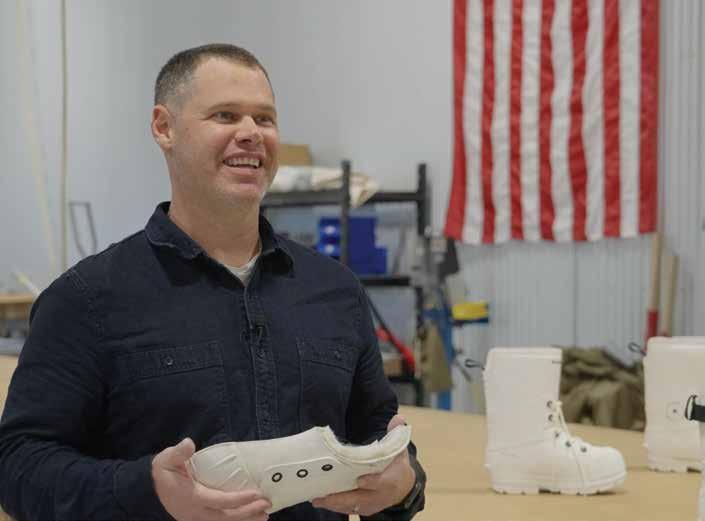
mainly composed of an outer shell of thin pieces of layered rubber, an inner layer of lofted and felted wool, and a waterproof footbed and lining.”
Britton continues, “The real advantage is that we have created a fully waterproofed, durable boot inside and out—a feature that no other boot on the market has and is really very difficult to achieve in the manufacturing process.”
Developing the Alaskan Bunny Boot presented a unique and complex design challenge for Britton. “This really was a very difficult boot to design for, one of the hardest of my career,” he says. “When the boot launched, I even had several older designers reach out to me to confess they had tried to create a similar product but had all failed in the manufacturing process for one reason or another. Sean and the Alaska Gear Company team have really created an awesome boot here, and I know it's just the starting line for them and innovation in the cold weather space.”

The design process had to balance several elements. “In this case, creativity, comfort, and practicality all have the same goals; they are not separate from each other but all working in tandem to make the best product for the end user,” Britton explains. “The biggest trade-off in this boot is that ease of manufacturing has pretty well gone out the window— but if it was easy to make it, it probably would have been done already. In nearly every other way, this is a better cold weather boot than what has been made previously.”
Britton should know.
Having been a footwear designer for twenty years and a size 9—the industry standard for footwear samples—he has personally tried on and corrected many hundreds, if not thousands, of shoes and boots over the years for best fit, he says. “There have been quite a few standards that have been developed over the 1,000plus years of shoe making, the 150-plus years of making vulcanized footwear, and the 20-plus years I have been immersed in it,” he says.
testers. His approach to thorough testing involves a variety of activities, from working in Prudhoe Bay to doing mundane daily tasks.
they are on track to be the best winter boot on the market.”

Aside from improving standards, fit, and function in the initial prototypes, testing materials, waterproofing, and flexion, Alaska Gear Company is now in the process of testing a significant number of boots on a broad range of people and end-use cases before production. “These will further inform the final design and initial production, and I don't anticipate the innovation and testing will stop there,” Britton says.
Alaska Gear Company spent two and a half years designing and engineering the Alaskan Bunny Boot to prepare it for the initial field testing. A diverse group of thirty individuals are evaluating the product, including a North Slope pipefitter, dog musher, wildlife biologist, ski coach, park ranger, reindeer herder, and several pilots.
Ben Parker, who has worked on the Trans-Alaska Pipeline System for many years, is one of the eager product
Parker’s initial assessment is overwhelmingly positive: “So far, these boots are fantastic, giving the old bunnies a run for their money. They are fabulously comfortable, and warm in the coldest, harshest weather I can throw at them.”
Having worn classic bunny boots since he was a teenager, Parker can compare the new to the old. “A couple issues with the old boots are they aren’t always easy to slip on and off (if laced up tight), and your feet are drenched in sweat after an hour or two, especially when wearing them in warmer climates like driving,” he says. “The new bunnies are excelling at these challenges. All day long, in and out of buildings, warm to cold, they somehow wick away moisture from my feet. The design of the upper part of the boot allows for quick entry. Instead of slipping on my Crocs, risking my socks getting wet in the fresh snow, I’ll slip on the new bunnies to go out and warm up my truck. I have about a month left for testing and have more challenges left for them to fully prove themselves. So far, I think
Bush pilot Jeremy Pepperd of Wasilla agrees. Pepperd—who flies for pleasure, not commercially— says the Alaskan Bunny Boot is an obvious improvement over previous versions of the boot. Traction is better, and the insole is a noticeable enhancement. Also, modifying the fit is as easy as adjusting the laces. “I’ve worn the original bunny boots for twenty-five to thirty years,” Pepperd says. “So far, the new ones are definitely more comfortable than the old ones.” Pepperd has used Alaskan Bunny Boots in weather as cold as 15°F below zero, and he says they were effective at keeping his feet warm and resistant to wear and tear. “I have worn them about seven or eight times, and there are no scuffs or scratches—no damage whatsoever,” he says. “I think overall they are better than the original bunny boots. I think the final design is going to be hands-down better than what we’ve been used to.”
Collective feedback from field testing will help Alaska Gear Company refine its design and manufacturing techniques to ensure the best possible product, according to McLaughlin. The company hopes to bring the Alaskan Bunny Boot to market this year, with the ambitious goal of manufacturing the product in Alaska. “If the initial launch goes well, that will fund/fuel the building of a domestic factory in Alaska to make the boots long term,” he says. “If the whole plan works, we expect to domestically source all the materials for the boot. If we can do that, the US Army is interested in the boot as well, but they require domestic sourcing. So, like most entrepreneurial endeavors, this thing happens in stages as we test the market and then deploy capital.”
As the saga of the Alaskan Bunny Boot’s development continues to unfold, one thing is clear: this innovative product has the potential to redefine cold weather footwear and revive a legend for a new generation of users.
At Northrim, we focus on serving the unique needs of Alaska and our neighbors who live here. We provide customized solutions to power your business, including specialized products such as fully FDIC insured sweep options and competitive analyzed accounts.
See how a Northrim expert can help your business achieve more.

By Katie Pesznecker
Un used for years, the Kaktovik airstrip on Barter Island idled in decay, battered by punishing Arctic coastal storms. Although the land was culturally important to Kaktovik’s Alaska Native people, the former US Air Force runway sat in a ruinous state, with 11,121 square yards of geocell material and 1,464 linear feet of steel drums that had been incrementally installed to protect the landing area from flooding and other show-stopping conditions over the decades.
Removing these materials, remediating the land, and restoring it presented a monumental task. A single company didn’t win the bid; two companies did. ChemTrack Alaska and Cornerstone General Contractors tackled the project under the auspices of their ChemTrack/Cornerstone Joint Venture (CTCSJV).
The partnership exemplifies the benefits that can result when contractors unite on joint bids. In this case, the joint venture blends smallbusiness ChemTrack’s record for environmental services, construction, engineering, and innovative remedial technology with the much-larger Cornerstone’s depth in coldclimate construction and massive, year-round projects.
It’s a win-win professional partnership, says Carrie Jokiel, ChemTrack’s president. ChemTrack is 51 percent owner in the joint venture; because it’s a small business, Cornerstone can bid in the small business category when the companies team up.
“The advantage for the small business is the person power, expertise, and sometimes bonding leverage the large business brings along with it,” Jokiel says. “For us specifically, our leadership is well aligned and has a strong personal friendship. We believe that is a differentiator for us. We enjoy working together, talking shop, and supporting one another on the wild ride of doing business in Alaska.”
The work on Barter Island presented a uniquely Alaskan opportunity, ending the lifespan of military infrastructure dating back decades. The story began with the forced move of Alaska Native people from their ancestral land;
“You have to bid a lot before you win. Have lots of open conversations. Make sure your goals are aligned. There’s a lot to it.”




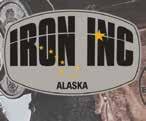












“A JV is a great way to be able to marry core competencies and compete on more projects… You are truly trying to make gains, learn, better your company, and support the people you work with.”
Carrie Jokiel President ChemTrack Alaska
with CTCSJV, it would end with that land remediated and presented back to its first people.
“We loved the idea of returning this area to its pristine natural landscape for the local community,” Jokiel says. “It brought us great pride to be a part of the bookend for this area.”
The community of Kaktovik is located on Barter Island in northeast Alaska adjacent to the Beaufort Sea. In the ‘40’s the US Air Force (USAF) decided to build an airstrip there—on the site of the historic Native village. The people of the North Slope Borough’s easternmost village had to abandon what had been their village site for generations.
Runway work proceeded. A hangar and the east-west runway were completed in 1947 on a narrow spit of land on the northeast portion of Barter Island. It had an elevation of less than five feet above mean sea level. As years passed, the runway experienced significant erosion and frequent flooding. In 1951, the entire area around Kaktovik was made a
military reserve, and some residents were required to move again. The village was moved once more in 1964, but this time, residents received title to their village site.
In the late ‘90s, the North Slope Borough operated and maintained the airstrip under a joint-use agreement with the USAF. During that time, the borough continued to install erosion control elements, including a revetment constructed of gravel-filled steel drums and a geocell confinement grid both above and below ground.
In July 2008, a severe winter storm submerged half of the runway, exposing and damaging several sections of the geocell materials.
In 2015, construction of a new airport began farther inland at an elevation above the 100-year floodplain. By 2017, the new airport was complete, and the Barter Island runway was abandoned. While airplane activity stopped, ferocious weather did not; storms continued to erode both sides of the spit, further exposing the geocell.
“The unknown subsurface steel drums were fragmented and posed

a serious health hazard to both the employees, our equipment, as well as the surrounding locals who use the Barter Island spit daily,” Jokiel says.
Several factors complicated the removal of these materials, such as the area’s archeological significance, the short work season due to sea ice and limited barge accessibility, and even polar bears, which frequent the area and attract wildlife tourism.
The project seemed like a great fit for the CTCSJV team, which had tackled several other jobs since forming in 2017.
“We were drawn to the idea that—even though there wasn’t typical contamination, in that it wasn’t contaminated—it was still environmental, in that it was cleaning up something that was a legacy item,” says Jenith Ziegler, ChemTrack’s vice president. “It was kind of the last piece of the puzzle. There had been a lot of contract work at the site before we got there, and this was the last piece to turn that over.”




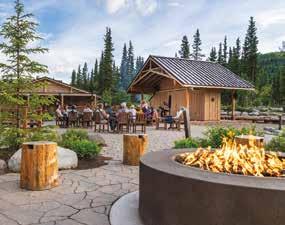



A joint venture is a marriage of disciplines, when two companies’ complementary skillsets combine to amplify their competitive edge and open new opportunities. With ChemTrack and Cornerstone working together, the team offers experience in every sector, construction delivery method, and region of Alaska.
“Our approach always balances the importance of performing safe, high quality, and efficient field activities with excellent operational planning, support, and coordination,” Jokiel says. “We pursue opportunities that are well-suited for the capabilities of our combined companies and highly qualified personnel.”
With the Barter Island project, CTCSJV saw areas for professionals from both companies to lend to its success.
“ChemTrack historically has performed work off the road system, where Cornerstone typically performs projects in larger communities,” Ziegler says. “Together we are able to look for opportunities in all areas of Alaska. We look for work where we both can contribute and find value.”
The Kaktovik shoreline is free of sea ice for about three months each year, from mid-July to mid-September. Even in that window, sea ice can float near the coast, driven by strong winds. This means barge service generally happens only once a season, which influenced CTCSJV’s schedule and approach.
The Barter Island project had two parts. The first entailed initial evaluation of materials on site, both visible and under the surface. The team discovered the project needed additional permits before beginning field work.
The discovery “saved the season,” Jokiel says. She credits the total synergy of CTCSJV and how team members meet regularly “under a cooperative framework to solve problems on paper long before construction begins,” as she puts it. This risk analysis, work planning, and upfront and continuous preparation uncovered the permitting lapse.
“Without our early discovery, acknowledgement by the USAF, and associated expedited permitting work by their staff, we would have missed

Alaska Owned & Operated Since 1979


www.chialaska.com info@chialaska.com
ph: 907.276.7667

We work as hard as you do to provide great service and insurance protection to our clients. Let us show you how to control your Insurance costs.

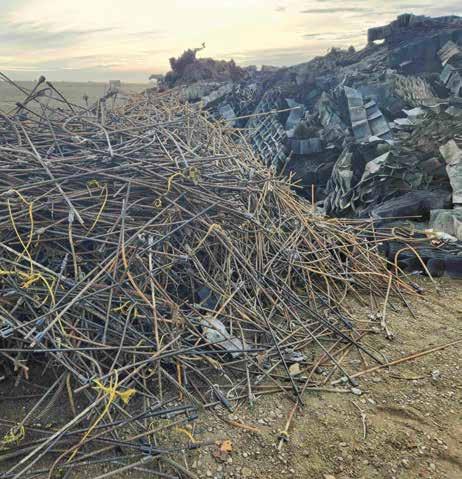
the short construction window available at Barter Island,” Jokiel says. When the start date arrived, the field teams worked in areas that did not require the missing permit. They were notified by the contracting officer when the permit arrived, just as they were about to leave. Crews were able to finish the site survey and investigation of concealed geocells.
“The client did not know how much geocell was initially installed, so we did not know how much there was to remove,” Ziegler says. “The first portion of our contract was to go up early in the season and excavate test holes. Those early test holes and related surveying provided the client with data to contract the remainder of the work.”
Namely, removal and disposal of all geocell and drum materials.
The Barter Island project included many standard Alaska construction project issues, such as scheduling constraints and harsh weather conditions. Kaktovik carried its own special challenges. Off the road system and north of the Arctic Circle, Kaktovik

ChemTrack & Cornerstone
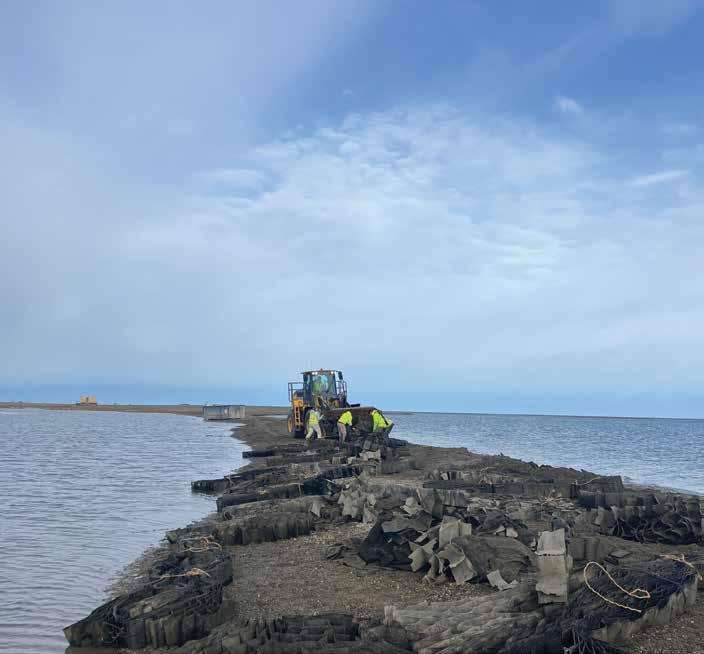
has limited amenities. Coordination with chartered barge and airlift services was essential to meet timelines.
“Due to the extreme remoteness of this project, safety was always in the forefront of the field team’s minds, and teamwork was essential in the execution of this project,” Jokiel says.
Polar bears are common in Kaktovik beginning in August, particularly near the old air strip where whale hunters often leave carcasses. CTCSJV trained staff to serve as armed bear guards. On one day, they spotted twelve polar bears.
The bears draw wildlife tourists, which required planning to make sure the CTCSJV team locked down its portion of the village’s limited hotel rooms.
Anytime ground was disturbed, archeological monitoring was in play. While nothing was discovered, it was contractually required to provide that service, Ziegler says.
The groundwork wrapped up after about three weeks, in time for a barge to remove the debris.
Jokiel says CTCSJV left the area “as close to its natural state as possible. Within a few days, even our equipment tracks were gone. This project was completed safely, delivering on-time and on-budget performance with excellent environmental results.”
The people of Kaktovik expressed gratitude throughout the project, Jokiel says.
“The crew was warmly received in Kaktovik,” she says. “We were educated by residents about the original townsite forced move. Elders were excited that we were there. They were thrilled to envision a beach free of metal debris and geocell fabric and matting. Residents showed up often to take pictures of the progress and our team. CTCSJV provided options for locals to re-use project materials for future trails. Our crew members were invited back for whaling s eason by the mayor.”
Further accolades came from industry peers. The Barter Island project won the 2023 Parker, Smith & Feek “Excellence in Construction, Meeting the Challenge of a Job Under $5 Million: Transportation, Heavy, Marine and Earthmoving”
“ChemTrack historically has performed work off the road system, where Cornerstone typically performs projects in larger communities… Together we are able to look for opportunities in all areas of Alaska. We look for work where we both can contribute and find value.”
Jenith Ziegler Vice President ChemTrack Alaska
award from the Associated General Contractors of Alaska.
The success stems from the partnership the joint venture represents, Jokiel says.
“A JV is a great way to be able to marry core competencies and compete on more projects,” she says. Companies considering it should “do it with someone you trust. If you’re like me, you aren’t trying to be a passthrough company; you are truly trying to make gains, learn, better your company, and support the people you work with.”
Ziegler adds that sometimes joint ventures struggle because of poor communication or failing to establish lines of responsibility early on.





Joined together years before the Barter Island runway project, ChemTrack and Cornerstone continue their venture with, for example, a project at the Fort Wainwright laundry facility.
ChemTrack & Cornerstone












“It’s different when you’re trusting someone else in a different building across town to do work that you both agreed to,” Ziegler says. “Are they going to prioritize you in the right manner? I think Cornerstone prioritizes ChemTrack, and I think ChemTrack prioritizes Cornerstone. It’s a really nice blend because they’re learning from us and we’re learning from them.”
A joint venture takes time to gain traction. Ziegler says, “You have to bid a lot before you win. Have lots of open conversations. Make sure your goals are aligned. There’s a lot to it.”
Joint ventures have their own rules and regulations, legal structures, reporting requirements, and more. They can also be temporary or long-term arrangements, with a specific end date or ongoing duration.
Ziegler categorizes CTCSJV “as a longterm joint venture. We leverage both companies’ expertise and resources.”
Other projects currently underway by CTCSJV include expanding laundry
rooms in barracks at Fort Wainwright, which entails adding plumbing and electrical service to support the US Army’s desired laundry-to-person ratio as much as feasible within the available laundry room space. The scope involves twelve barrack locations and thirty-five laundry rooms.
CTCSJV is also the prime contractor on a heat extraction project for a computer server room on the Army post. Work includes mitigating the heat load, providing power and grounding to server equipment, providing back-up uninterruptible power supply to additional equipment, repairing exterior portions of the building, and repairing maintenance hole covers and frames.
“We are truly lucky to have an amazing JV partner with Cornerstone,” Jokiel says. “The leadership has a friendship deeper than business, and that attitude runs through our folks that work with us too. We see it in our meetings, in our projects and in our approach to future work. It’s awesome to have success and enjoy working with folks you like.”




















By Nancy Erickson
Wh ether on foot, by dog teams, or in kayaks, the Iñupiat people of Alaska’s North Slope maintain a mobile culture, traveling great distances through a harsh climate. Hunters follow bowhead whales to summer feeding grounds or track caribou herds to the upper Utukok and Colville rivers. Traditional navigation across the mostly featureless terrain involved specific landmarks or the stars.
Inter-village travel is faster and easier in an era of snowmachines, all-terrainvehicles, trucks, and cars. Residents of Wainwright or Atqasuk might go to Utqiaġvik for shopping or medical appointments, says James Koonaloak, field operations manager for Eskimos, Inc., part of the Arctic Slope Regional Corporation family of companies.

Cultural events, basketball tournaments, community celebrations, and family visits draw residents between villages. Many of these trips are made by airplane or boat, given that the only cross-country road in the North Slope Borough (NSB), a land area larger than Utah, terminates at Deadhorse.
Yet land routes remain an option, says Jocelyn Pili of Utqiaġvik. “While air travel and barge shipments remain crucial, the historical interconnectedness of villages via ‘tundra travel’ is vital. Traditional hunting practices and other activities, like bartering and
trading, have shaped the land routes used today,” she says.
Away from the coast, the communities of Atqasuk and Anaktuvuk Pass are landlocked, yet they need regular deliveries of bulk fuel for electricity and heat. “The only way in and out of there with freight is either overland in winter or large equipment via air,” says Jake Wise, an equipment operator with Ukpeaġvik Iñupiat Corporation (UIC).
That overland option is known as the Community Winter Access Trail (CWAT), a seasonal land link for North Slope villages.
“Communities in the Arctic were never intended to be isolated and detached from the rest of the world,” says Don Gray, vice president of UIC Oil & Gas and Marine Services. “The CWAT allows Alaska Native residents in the central Arctic communities to enjoy the same transportation rights commonly enjoyed by the majority of US citizens.”
Utqiaġvik, Wainwright, and Atqasuk are surrounded by the National Petroleum Reserve-Alaska (NPR-A) managed by the US Department of Interior. Thus, crossing the reserve


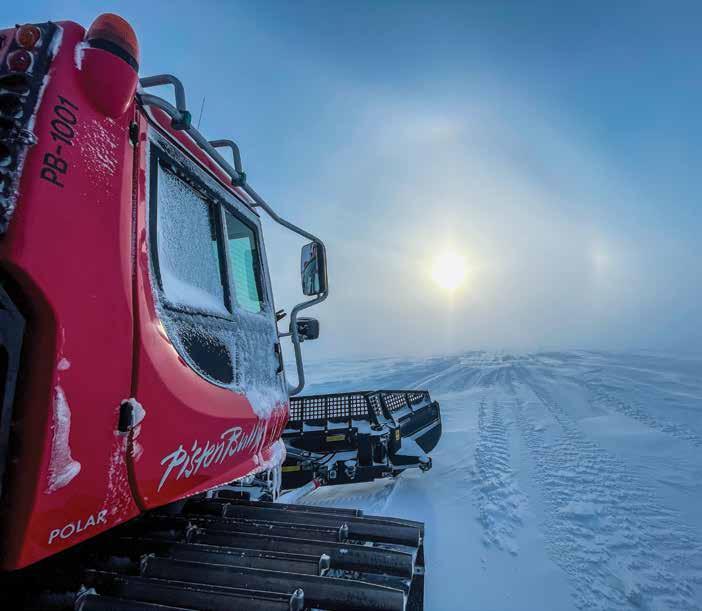
requires federal permission. The US Bureau of Land Management (BLM) Arctic District Office, in cooperation with the State of Alaska and NSB government, authorized a right-of-way through NPR-A starting in January 2019. The CWAT program initially had a fiveyear sunset date, but the permit was recently renewed for another five years.
Broken into two sections, CWAT follows historic snow trails used by traditional hunters. The Northern Route heads west from Prudhoe Bay to Utqiaġvik and Wainwright along the coast and inland to Atqasuk.
The Southern Route starts from Galbraith Lake along the Dalton Highway and traverses west across the foothills of the Brooks Range to the community of Anaktuvuk Pass.
The trail is meticulously constructed annually using compacted snow. Low
ground-pressure equipment prevents damage to the fragile tundra beneath. Once the route sets firmly, weekly caravans escort private vehicles.
Commercial freight haulers under their own permits also make use of the trail system.
Eskimos, Inc. is CWAT’s prime contractor. According to Koonaloak, setup typically starts as early as late December with trail reconnaissance and pre-packing. In January, snow trails and ramps for river and creek crossings are constructed and trail markers and signage installed.
Escorted caravans can start as early as mid-February and continue through April. During this period the trails are groomed and maintained, especially after snow drifts created by winter
The sunset date for the CWAT right of way, much like sunsets during the Arctic summer, has been extended. Instead of ending this year, the trail will last for another five, at least.
storms obliterate the route. Trails are decommissioned at the end of the season, removing all trail markers and signage. However, this schedule is driven entirely by weather.
Only vehicles approved by the Alaska Department of Natural Resources for tundra travel are used to build and maintain the trail. Typical equipment includes Tucker and PistenBully snowcats mounted on huge rubber tires or tracks, says Koonaloak.
Equipment operator Wise, originally from Homer, knows the trail well. He begins building the trail from Prudhoe Bay to Utqiaġvik using a PistenBully 600 snowcat, then 127 miles from Utqiaġvik to Wainwright, and 68 miles Utqiaġvik to Atqasuk as well. Some years the crew runs to Point Lay, 220 miles southwest of Utqiaġvik on the coast.
From a mom-andpop business to a leading wireless communication provider, Arcticom, LLC has experienced a remarkable transformation in its ten years as an active subsidiary of Bering Straits Native Corporation (BSNC). When it was acquired by BSNC in 2013, Arcticom was supplying high-end radio solutions. Under BSNC’s guidance, the company has expanded its technology offerings and financial capabilities, solidifying its position as an industry leader. “We’ve accomplished a lot in ten years; we have grown Arcticom more than 100 times larger,” says Arcticom General Manager Bruce Hellenga. “It feels awesome.”
Being part of BSNC unlocks significant advantages that enable Arcticom to achieve its mission of providing cutting-edge wireless technology that boosts productivity and exceeds customer expectations. BSNC’s financial backing allows Arcticom to expand its strategic capacity to complete larger projects. Hellenga explains: “Because we have several subsidiaries, we have bigger reach-back capabilities where we can use employees and assets from other companies to get work done.”
With its diverse capabilities, Arcticom serves clients in various industries, including oil and gas, construction, and mining.
Its offerings encompass network engineering, data center design, radio systems, hardware and software integration, and maintenance services. Arcticom also supplies best-in-class equipment to support the unique requirements of first responder networks like FirstNet and E911.
Partnering with industry leaders like Motorola and AT&T allows Arcticom to provide the latest technology—which can be critical for optimizing cellphone service and internet connectivity. “Technologies change rapidly, so you have to surround yourself with people who can keep up,” Hellenga says. “For example, 5G doesn’t penetrate concrete and metal buildings very well, so you have to put in antenna systems to get better coverage.”
Boasting an impressive portfolio of federal government contracts, Arcticom serves agencies like the US Air Force, Department of Justice, General Services Administration, and US Census Bureau. Arcticom is proud to be a Small Business Administration 8(a) certified contractor with exceptional ratings and commendations for its performance. Safety is also paramount, which is why Arcticom begins every meeting with a safety moment.
Hellenga attributes Arcticom’s ability to deliver efficient, competitively

priced work to its skilled workforce, which is supported through ongoing training. In addition, Arcticom stands by its work. "If something goes wrong, we fix it at our expense," Hellenga says.
This commitment to excellence fosters “trusting relationships” that generate repeat—and word-ofmouth—business from companies that value honesty and a strong work ethic. “They know we’re going to do the work, at a fair price, and to their satisfaction,” Hellenga explains.
As a for-profit, Alaska Native-owned business, Arcticom has a broader purpose: to develop capabilities that benefit its company and shareholders. “We like to be able to enhance communications and IT systems—especially in our region,” Hellenga says. “If there’s an opportunity to make rural communities a better place for shareholders to sustain their culture, we want to provide that.”
Contact us to see how Arcticom can support your communication needs in Alaska and beyond.

by Amber Johnson Photography

Pushing a 20-foot-wide blade, the huge snowcat is mounted on tracks and supports a house that sleeps two comfortably, as well as all the tools and spare parts needed to get the job done safely. Below the cab is a 575-gallon auxiliary fuel tank and lubricant storage.
“I spend most of my hitches living out of this cat,” says Wise. “Only three of the last thirty-four days have I slept in camp.”
Traveling the 300 miles from Prudhoe Bay to Utqiaġvik can take twelve days initially.
“Every day is an adventure up here. The weather’s always changing,” says Wise. “It can go from 20°F above to 65 or 70°F below, ice fog to sunny days to Phase 3 visibility, driving by GPS navigation only.” In the heart of winter, of course, there are no sunny days; north of the Arctic Circle, the sun barely rises above the horizon from October to March.
Breaking trail at the beginning of the season is slow and rough. “It’s a desert up here,” he continues. “You get your snow in October and November and a little bit in December. A few snowstorms later, most of the snow is
just blowing around, from one end of the Slope to the other.”
Travel time diminishes to as little as three days after the snow trail sets, ready for limited public use.
Winter storms occur frequently, producing white-out conditions. A lone driver can easily become disoriented, unable to make life-saving decisions.
To prevent that from happening, travel by private vehicles on the CWAT is only done under escorted caravans. Commercial freight haulers may travel unescorted.
The Safe Traveler’s and Environment Program developed by Eskimos, Inc. and NSB Planning and Community Services requires an orientation course for caravan drivers. Vehicle inspections determine the trail worthiness of the vehicle. Vehicles must be clean, 4-wheel or all-wheel drive, with tow connections in the front and rear, sufficient fuel capacity, and two licensed drivers per vehicle, among other stipulations. Eskimos, Inc. or subcontractors, which include UIC, conduct the
caravans with two vehicles, one at the head and one at the end of the caravan, says Koonaloak. Escort vehicles are equipped with all safety equipment, extra fuel, communications gear, and tow sleds to assist a stuck or disabled vehicle.
If a caravan is caught in a blizzard, the caravan leader and support staff direct the drivers to hunker down in their vehicles until the storm passes or drive safely through it, says Kristin Gutierrez-Edwards, NSB’s assistant to the land management administrator and acting deputy director of planning. She experienced a storm while driving a car up the CWAT, but the caravan was able to drive through it by going slowly and safely.
The eastbound Northern Route ends at a drill pad east of the Colville River near Deadhorse, but escorted vehicles are brought to nearby Harry K. Brower Jr Technical Training Center for staging. From there, drivers continue on the 414-mile Dalton Highway to Fairbanks or beyond. The haul road, famously lonesome on its own, is like a freeway after days on CWAT.


NSB records indicate fifty-eight caravans including approximately 140 vehicles made the 3-to-33hour trek across the tundra during the 2022-2023 season.
In addition to being a lifeline for villages, CWAT is a business opportunity for freight couriers.
Blue Goose Hauling is fairly new to the transport business, established in 2022 in Utqiaġvik. Jocelyn Pili co-owns the service with her husband, Zach, and the business is named in honor of Zach’s maternal great-grandparents. They ran the Point Barrow Trading Post in the ’60s and ’70s under the VHF radio handle “Blue Goose Base.”
Prompted by requests from family and friends for assistance with transporting vehicles, the Pilis were inspired to establish their own business. CWAT makes that possible. “The development has enhanced opportunities for North Slope communities by enabling transportation of larger equipment, vehicles of all sizes, and housing materials to their hometowns and all the villages in between,” says Jocelyn.
Trail conditions have improved since CWAT’s early years, Zach adds. In the first seasons, the trail was rough and lacked markers, but now trails are smoother, and the route has signs and delineators as well.
Blue Goose Hauling recently won the North Slope Marketplace business plan competition, with a purse of up to $25,000. The company also recently acquired a new snowcat, a 2011 Prinoth BR350 Beast equipped with a Cat-C13 ACERT engine, capable of towing 5 tons of cargo.
One of the first companies to transport cargo overland between Deadhorse and Utqiaġvik was Arnie’s Northern Outfit & Cargo. Arnie Arey started the company pre-CWAT, in 2010, by modifying a heavy-duty pickup truck with tracks instead of tires and building a custom 22-foot-long sled.
Now a CWAT traveler, Arey started his 2023-2024 season March 1, patiently waiting for a call to pick up freight at the Utqiaġvik airport and take it to Wainwright. Some years it’s difficult to get motivated, Arey says, but it’s the people and the companies who need his services that keep him going.





According to the North Slope Borough, the winter of 2022-2023 saw 140 vehicles using CWAT, escorted in more than fifty caravans. UIC Oil & Gas

“Communities in the Arctic were never intended to be isolated and detached from the rest of the world… The CWAT allows Alaska Native residents in the central Arctic communities to enjoy the same transportation rights commonly enjoyed by the majority of US citizens.”
Don Gray
Vice President, UIC Oil & Gas and Marine Services
Depending on the order and the weather, he and his crew of two or three drivers can make the trip to and from Fairbanks in four days, nonstop, taking turns sleeping.
Building materials are always popular, and Arey is taking notes. “I want to build myself a house, so I’ve been hauling stuff like that so when it comes to building my own, I have all the experience with what I need. I can hire myself,” he says.
The cost of building a home in Utqiaġvik is $600 per square foot, says UIC’s Gray. “Which means it will cost you $600,000 to build a 1,000-square-foot mobile home. Wells Fargo is not going to give someone a
$600K loan to build a 1,000-squarefoot home. This means you have three or four generations living in a household,” he says.
Apart from housing, the cost of living is notoriously high. Milk can be more than $10 a gallon, and a twelve-pack of soda costs up to $17. Roundtrip airfare from Utqiaġvik to other villages runs from $374 to $554.
And mail order has limitations, says Frank Payuk Damiano, BLM’s community outreach specialist for NPR-A. “I can get almost anything I want through Amazon, and most of the time I don’t have to pay for shipping. It might take a month, but it still gets here,” he says. “But the big things— those building materials or vehicles— you can’t order that through Amazon.”
The CWAT program is helping alleviate some of that burden.
“Village residents are now able to drive vehicles to bigger cities/villages and have lower costs of goods and supplies,” says Gutierrez-Edwards. “Compared to a barge service or cargo service that may charge thousands of dollars, they can now go and purchase their goods at lower prices.”
“It’s really wonderful for the communities,” Damiano says.
In Gray’s opinion, CWAT is proof of concept for possible future infrastructure. “The only thing that will cut the cost of building in the Arctic by half is a road. The CWAT helps connect, but ultimately it needs to be used to show how vital a year-round road is to having a healthy, strong community,” he says. “You have to build connections.”
Committed to Alaska for more than 50 years.
ConocoPhillips Alaska and the successes of its heritage companies date back to the greatest oil discoveries in Alaska history. Today we continue our tradition of developing, innovating and delivering value for Alaskans.

Richfield Oil Co. drills the first well in the Swanson River field and strikes oil.
1957 Alaska becomes the 49th state. 1959
Sinclair Oil Co. discovers the Kuparuk River field.
ConocoPhillips Alaska Inc. begins developing the Alpine field using horizontal well technology. 2000 ARCO discovers oil in the Prudhoe Bay field.
1968
1969
Final Investment Decision is made to develop the Willow project. 2023
Learn more
By Vanessa Orr

Cruise ship tourism in Alaska has recovered from the COVID-19 wipeout, and then some. The Alaska Travel Industry Association reports that nearly 1.7 million cruise ship passengers saw the state in summer 2023, up from an estimated 1.2 million in 2022 and higher than the pre-pandemic peak of 1.3 million in 2019.
About 43 percent of Alaska’s visitors come by cruise ship, so the industry is expanding to accommodate the growth. For example, the season started about two-and-a-half weeks earlier in 2023 than in the previous year, and the season extended past mid-October. Cruise companies are also creating new tour packages for passengers to enjoy aboard ship and during port calls.
Shoreside accommodations in Southeast are well developed and getting better every year, so the most room for growth is westward, across the Gulf of Alaska.
Two of the newest offerings come from Princess Cruises, marking its 55th anniversary of sailing in the region.
The company, part of the Carnival Corporation family, has seven ships sailing from West Coast ports. From June 8 to August 29, these ships, which carry an average of 3,172 guests each, are participating in thirtytwo voyages, which the company packages as “cruisetours.”
Guests can choose from sixteen northbound “Voyage of the Glaciers” cruises from Vancouver, British Columbia to Whittier aboard Grand Princess , Royal Princess , or Sapphire Princess , or sixteen southbound cruises going the other direction. These cruisetours include a new adventure to Katmai National Park and Preserve, as well as a fifteennight visit to five of Alaska's most breathtaking national parks.
“Guests choose Princess more than any other cruise line to set their sights on untamed wilderness, majestic glaciers, close-up wildlife, and Denali,” says Princess Cruises





Vice President Lisa Syme, adding that Princess takes more guests to Alaska’s most-visited national park, Glacier Bay, than any other cruise line. “These new cruisetours reflect our commitment to deliver an enriching journey that allows our guests to explore more of Alaska while creating lasting memories.”
The Katmai National Park Cruisetour, which was announced in December 2023, gives guests three days in Anchorage before or after their cruise, flying from there to King Salmon to reach Brooks Lodge for a day to observe the park’s famous brown bears eagerly welcoming the return of sockeye salmon.
Established in 1918 to protect the volcanically devastated region surrounding Novarupta and the Valley of Ten Thousand Smokes, Katmai National Park and Preserve also protects 9,000 years of human history and important habitat for salmon and thousands of brown bears. These mammoth animals, which can each weigh between 600 and 900 pounds, compete for the best fishing spots. The hungriest bears can catch and eat more than 120 pounds of salmon—or about forty fish—each day.
“While you may see bears in other places around the world, you won’t see bears like this,” says Matt Johnson, interpretive program manager and public information officer at Katmai. “These bears don’t normally congregate together in nature, but they do tolerate each other around the falls during the salmon run because there’s plenty of food for them.”
A trip to Katmai starts with registration at the Visitors Center and a mandatory “bear camp” to learn how to deal with the local bruins (such as moving off paths to give bears the right-of-way). Visitors have the option of wandering trails in the area or walking the 1.2-mile trail directly to Brooks Falls to watch the bears.
“At the falls, there is a platform where people can view bears to get an upon-high view and to also have some measure of safety,” says Johnson. “There is also a bridge farther downriver from the falls where they can see the bears from a platform as well.”
Buses run daily to take visitors into the Valley of Ten Thousand Smokes,
“This area has been active with humans and bears for many years, and you can see evidence of the people who came before at a cultural site featuring interpretive displays not far from Brooks Camp itself; it’s just a short hike… The archeological site is fascinating.”
where there are more than a dozen active volcanoes as well as numerous archeological wonders. Hiking is available in that area, and there are also shorter hikes up Dumpling Mountain from Brooks Camp and other trails around the camp itself.
The site is rich in cultural attractions, Johnson notes, as communities have used the resources of the Valley for more than 5,000 years. “This area has been active with humans and bears for many years, and you can see evidence of the people who came before at a cultural site featuring interpretive displays not far from Brooks Camp itself; it’s just a short hike,” he explains. “The archeological s ite is fascinating.”
Visitors to the area from June 1 to September 17 may also take advantage of daily ranger-led programs at the park’s auditorium. As part of the Princess cruisetour, a lunch is provided, as well as an exclusive souvenir designed just for Princess guests.
“This new Katmai National Park Cruisetour offers our guests a deeper connection and intimate bearwatching encounter in their natural habitat,” Syme says. Although only introduced this past winter, she says response to the Katmai National Park Cruiset our has been strong.
The Katmai Park Cruisetour combines a seven-day cruise with two hotel nights in Anchorage. Including flights to and from Katmai National Park and all transfers, rates start a t $2,429 per person.
Depending on the route chosen, the fifteen-night National Parks Cruisetour ranges from $3,597 to $4,017.






With approximately 35.7 million passengers expected to cruise worldwide in 2024, cruise lines are hustling to create products and itineraries that attract those who choose this mode of travel. While previous generations may have been satisfied with spending most days at sea, the younger generation wants to spend more time visiting destinations and taking part in authentic travel experiences.
According to Cruise Lines International Association, there is more interest than ever before among Millennials and Gen X travelers to take their first cruise. Approximately 7 percent of Millennials are at the age where a first-time cruise vacation grabs their interest, 73 percent of Gen Xers are. Of those who have cruised before, 88 percent of Millennials and 86 percent of Gen Xers say they plan to cruise again.
To meet this demand, cruise lines are offering both shorter and longer itineraries. While the average cruise length continues to be around seven days, the range of options has expanded, including overnight stays in certain ports of call. For example, Princess Cruises’ new National Park Cruisetour includes seven days at sea and eight days on land.
Cruise Lines International Association reports that 50 percent of current and potential cruise travelers say that they are more committed to making travel decisions based on environmental impacts than they were three years ago. Thus, cruise lines are offering environmental education and sustainable tour experiences.
Travelers are also becoming more interested in expedition cruises, which are smaller than traditional cruises and designed to provide immersive, active, responsible experiences that focus on nature. The number of passengers on expedition cruises more than doubled from 2016 to 2022; during 2022, 137,000 cruise travelers sailed on expedition ships, and that number is expected to grow.

The package lets guests explore Glacier Bay, Denali, Wrangell-St. Elias, and Kenai Fjords National Parks, as well as Klondike Gold Rush National Historical Park in Skagway. This experience combines a seven-day cruise, scenic rail travel, and eight nights on land, including stays at four Princess-owned wilderness lodges.
Designed for “explorers and wanderers,” this cruisetour has port calls in Whittier, Skagway, Juneau, Ketchikan, and Vancouver, British Columbia as well as scenic cruising at Hubbard Glacier and Glacier Bay National Park and Preserve.
Each park is its own unique destination: visitors can bask in the splendor of Alaska’s pristine landscape at Denali National Park and Preserve, home to the tallest mountain in North America at roughly 20,310 feet. Views at Wrangell-St. Elias National Park and Preserve, the largest national park in the US (equal to six Yellowstones) include sweeping glaciers and nine of the nation’s sixteen highest mountain peaks, as well as unique Klondike gold rush history.
The Harding Icefield in Kenai Fjords National Park comprises forty glaciers that carved the fjords and continue to feed into the ocean. Across the Gulf
of Alaska, Glacier Bay is a UNESCO World Heritage Site famous for its bright blue ice and grizzlies wandering the shore. And Skagway’s National Historic District takes visitors back to the 1890s, where Klondike gold rush stampeders made their way to th e Yukon gold fields.
Because Princess owns and operates five wilderness lodges in Alaska on the doorsteps of sought-after national parks, cruisetour guests can enjoy time exploring the vast interior of the state.
At two of the lodges—Fairbanks Princess Riverside Lodge and Copper River Princess Wilderness Lodge— food service includes “garden to table” menus with fresh, local ingredients, depending on harvesting seasons.
An onboard amenity new for 2024 is “Voyage to the Stars,” a planetarium in the Princess Theater. “The presentation introduces them to the beauty and wonder of the aurora borealis featuring live imagery,” says Syme.
As long as a cruise to Alaska remains a “bucket list” vacation wish, cruise lines will come up with new ways to make those dreams come true. Syme says, “Alaska is a unique and awe-inspiring destination, and our guests want to experience an up-close look at the wildlife of the Great Land.”

By Mikel Insalaco
Al aska’s Railbelt region refers to the area serviced by Alaska's interconnected electric grid stretching from the Kenai Peninsula through Anchorage and the Matanuska-Susitna Borough, north to Fairbanks. According to the Alaska Energy Authority (AEA), the Railbelt functions more like an “energy island.” This isolation is compounded by the Railbelt's structure; AEA likens the three regions to a "single extension cord." This is unlike the Lower 48, where grids can tap into a vast network of power sources via multiple pathways.
The Alaska Center for Energy and Power (ACEP) at UAF recently completed an exhaustive exploration into the Railbelt grid's future. This report focused on navigating the complex factors of energy infrastructure such as reliability, affordability, and clean energy development for the region. The project's purpose, outlined in extensive consultation with Alaska's energy community, was to inform future decisions and studies by utilities, the State of Alaska, and other stakeholders through a detailed evaluation of resource mixes, electrification impacts, operational and reliability implications, and the potential costs of a decarbonized power system.
Renewable energy sources, such as wind and solar power, offer a promising avenue for reducing the Railbelt's carbon footprint. The ACEP study, supported by the Hawai’i Natural Energy Institute and US Office of Naval Research, concludes that Railbelt communities could generate 96 percent of electricity from non-fossil-fuel sources by 2050.
But there's a catch: the conversion would cost up to $12 billion dollars. Integration of renewable energy sources introduces a set of unique

challenges. Unlike coal, gas, or dieselfired turbines that can be easily turned on or off to match demand, wind and solar power are intermittent, requiring advanced management strategies to ensure grid stability. Furthermore, these sources generate direct current, which must be switched by inverters into the alternating current that energizes the grid. These inverters represent both a challenge and an opportunity for innovation in how renewable energy is integrated into the Railbelt's energy mix.
To carry out the study, ACEP collected input from stakeholders to quantify and evaluate potential scenarios for diversifying the Railbelt electric grid, while comparing each scenario's contribution to decarbonization.
“When we started this project two years ago, we decided to name it a 'decarbonization study' because of the interest in establishing an RPS [renewable portfolio standard] or clean energy standard. However, the model we've developed is really a technologyneutral tool,” says Gwen Holdmann, associate vice chancellor for research, innovation, and industry partnerships at UAF. “It's intended to help identify a sustainable mix of energy resources capable of satisfying the Railbelt's future energy requirements without compromising system stability.”
Holdmann was the director of ACEP when the study began in 2022. The final product released for public comment earlier this year ended up somewhat different from what researchers anticipated. “So we're considering rebranding this effort in the future to make it clear this can encompass a diverse array of energy resources and generation sources,” Holdmann says.
Acknowledging the limitations of any single method to cover all aspects of power system planning, the study adopted a multi-modal approach. This strategy allowed for a detailed examination of different grid configurations, integrating renewable energy sources like wind, solar, tidal, and hydro, alongside traditional energy sources and emerging technologies such as nuclear power and battery energy storage systems. A core concept of the study was a power system
simulation and modeling process, utilizing advanced software tools that are widely recognized and employed by utility entities nationwide, including those within the Railbelt network.
The study delved into four detailed scenarios to explore the future of the Railbelt electric grid diversification. These scenarios explore the interplay between different energy sources, the technological and economic implications of their integration,
and the broader impacts on grid reliability and sustainability.
Scenario 1: Business as Usual. This scenario envisages minimal shifts toward renewable energy. It projects the construction of new fossil fuel units to meet increasing energy demands, with renewables making up 11 percent of the energy mix. This scenario, requiring a capital investment of $2.3 billion (in 2023 dollars), anticipates a generation and transmission cost of $119 per megawatt-hour (MWh), setting a benchmark for comparing

“Each utility serves its customers first and the larger system second… While appropriate, that dynamic does not always work to the benefit of the Railbelt as a whole. However, there is a consistent effort by all of the utilities to collaborate on Railbelt-wide efforts.”
Curtis W. Thayer Executive Director Alaska Energy Authority
other options and the economic and environmental impacts of more ambitious decarbonization efforts.
Scenario 2: High Renewables. This scenario represents a significant pivot toward wind, solar, and hydroelectric energy, incorporating the SusitnaWatana Hydro project (475 MW), 1,022 MW of wind, and 472 MW of utility solar. It aims for renewables to contribute 88 percent of the required energy, supported by 1,243 MW of new battery storage to enhance grid stability. The scenario requires substantial capital investment of $11.8 billion and yields a generation and transmission cost of $134/MWh. This mixture of investment highlights the indispensable role of battery storage for a renewable energy grid in addressing the challenges of intermittent power production.
Scenario 3: Tidal Integration. Introducing a novel element of technology yet to be deployed at commercial scale anywhere in the US, this scenario explores the addition of a 400 MW tidal power plant in Cook Inlet, alongside 924 MW of wind and 190 MW of utility solar. It aims for 70 percent renewable energy generation, complemented by 750 MW of new battery storage and upgrades to the Alaska Intertie. With a required capital investment of $7.7 billion, this scenario presents a generation and transmission cost of $128/MWh, offering insights into the potential and economic viability of integrating tidal energy into Alaska's renewable portfolio.
Scenario 4: Small Modular Nuclear Reactors. Envisioning a near-complete decarbonization, this scenario considers the deployment of small modular nuclear reactors in addition to 1,056 MW of new wind and 328 MW of utility solar, aiming for 96 percent zero-carbon generation. It also plans for 1,518 MW of new battery storage and Alaska Intertie upgrades. The scenario outlines a capital investment of $10.1 billion and a generation and transmission cost of $128/MWh, illustrating the role nuclear energy could play in achieving deep decarbonization.
The scenarios explored in the study reveal substantial capital investment requirements, ranging from
approximately $7.7 billion to $11.8 billion (in 2023 dollars). These figures reflect not only the high costs associated with Alaska-specific capital and operations but also the inclusion of certain highcost projects without prior economic screening. The magnitude of these investments highlights the financial challenges of transitioning to a lowcarbon grid, necessitating innovative funding solutions and strategic investment planning.
Some of these efforts stand to benefit from federal funding, but there are challenges. According to the AEA, a pivotal concern in funding the transition is the current uncertainty surrounding Clean Energy Tax Incentives. “The Internal Revenue Service has not yet issued its final determination on the Clean Energy Tax Incentives, as part of the Inflation Reduction Act (IRA),” the authority states (while cautioning that it does not offer tax advice). “In the meantime, AEA recommends that prospective energy project developers consult professional tax advisors for accurate information about whether IRA tax credits may be applicable to their respective projects. In addition, IRA tax credits are very specific and apply to only certain aspects of a clean energy project, with bonus credits available for projects that meet certain additional criteria. Clean energy tax credits are likely to benefit clean energy development and may reduce ove rall project costs.”
The success of Railbelt decarbonization depends on overcoming the intertwined challenges of funding, regulation, technology integration, and stakeholder alignment. Another hurdle is that the Railbelt is split into five customer-owned cooperatives: Golden Valley Electric Association, Matanuska Electric Association, Chugach Electric Association, Homer Electric Association, and the municipal Seward Electric System.
“Each utility serves its customers first and the larger system second,” says AEA Executive Director Curtis W. Thayer. “While appropriate, that dynamic does not always work to the benefit of the Railbelt as a whole. However, there is a consistent effort by all of the utilities to collaborate on Railbelt-wide efforts.”
Thayer points to regional collaborations such as the committee that manages the Bradley Lake Hydro Project near Homer for the benefit of the entire grid. Utilities also work together to manage the Alaska Intertie that allows electricity to flow between Southcentral and the Interior. More recently, they formed the Railbelt Reliability Council. “These entities may represent the best example of collaboration between the different member utilities on the Railbelt today,” Thayer says.
The utilities have a lot to learn in the time it would take to implement any of the decarbonization scenarios.
“Currently there is limited operational experience of running the Railbelt with large inverter-based resources such as wind and solar,” says Holdmann. “There will be a significant learning curve with the first large wind project for dispatchers and operations engineers. Therefore, changes and additions are best done in incremental steps.”
One of the most compelling arguments for pursuing a decarbonized energy pathway is the promise of long-term economic benefits. These include stabilized energy prices, enhanced energy security, and the retention of capital within the state's economy. Additionally, clean energy resources and related industries could spur job creation, attract investment, and facilitate economic diversification.
Indirectly, the stabilization of energy costs on the Railbelt has far-reaching implications for the cost of living and doing business across most of the state. According to AEA, lower energy costs on the Railbelt, where about 70 percent of Alaska’s population lives, could lead to reduced rates for rural communities through mechanisms such as the Power Cost Equalization program, thereby addressing one of Alaska's longstanding challenges: the high cost of energy in remote areas.
Additionally, the focus on energy efficiency and electrification, particularly in the areas of transportation and heating, may offer avenues for innovation that help communities be more economically resilient.
Findings from the study emphasize the importance of strategic planning and policy support to navigate the economic complexities of decarbonization. It highlights the need for a holistic approach that considers not only the immediate costs but also the longterm economic benefits.
“One of the most important things learned from this project was how to address these types of questions and what tools to use to solve them,” Holdmann says. “Methods for performing system planning for electric grids have
evolved substantially in the last few years and will likely continue to, as there is more variability in energy resources and the inverter-based resource technology changes and improves. This necessitates new types of modeling not previously needed to capture the potential new types of stability and resource adequacy challenges.”
The ACEP study presents a vital roadmap for navigating the energy transition, balancing technical feasibility with economic and social considerations.



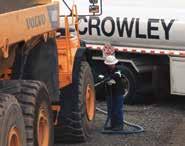
With terminals and delivery services spanning the state, and a full range of quality fuels, Crowley is the trusted fuel partner to carry Alaska’s resource development industry forward.


The history of oil in Alaska dates to the end of the Paleozoic Era, 250 million years ago. Biological material in shallow seas of the late Permian Period compressed into rock, cooked under pressure until crude oil and natural gas collected under formations such as the Barrow Arch underlying Prudhoe Bay. Yada yada yada, 20th century explorers punched holes that released the resource, powering the economy and society of the state.
Along the path from pre-dinosaurian sludge to precious commodity, footprints mark the presence of bold companies and hard-working individuals that shaped the industry in the past and continue to innovate today.








Over 50 years of experience in industrial, commercial and technical services
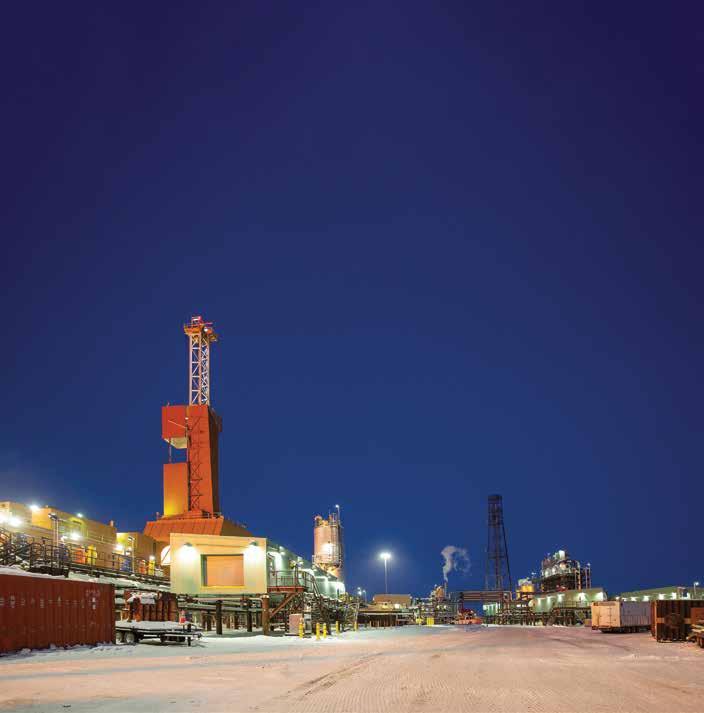
Big things are in store for Alaska’s biggest crude oil producer.
ConocoPhillips Alaska, Inc. announced last year that it intends to continue pumping $1 billion per year into its legacy projects in the state while also pursuing new projects. With 1.2 million net undeveloped acres as of the end of 2022, ConocoPhillips Alaska is the largest owner of exploration leases.
“When I think about this track record of adding new development, ConocoPhillips Alaska has more than fifty years of experience on the North Slope safely exploring and discovering
By Alexandra Kay
new resources and developing new projects and also being a trusted partner for the state in creating wealth for the communities,” says Vincent Lelarge, vice president of Alaska asset development. “With the people and the technology and the skills we have—and with a stable fiscal environment—we have the potential to continue this trend of value creation for decades.”
And that’s good for the state, says Kara Moriarty, president and CEO of the Alaska Oil and Gas Association. “From our perspective, anytime you have a company making major investments in Alaska, it continues the long-term
viability of our industry and for us that’s our main mission,” she says.
Altogether, oil and gas companies provided $4.5 billion in state and local revenue in 2022 and supported more than 69,000 direct and indirect jobs in Alaska. That year was significantly buoyed by one new ConocoPhillips Alaska project, Greater Mooses Tooth 2 (GMT2), which hints at the potential contained in the planned Nuna and Willow developments.
Ensconced in Alaska’s tallest building, ConocoPhillips Alaska is not
just the state’s largest producer but, in a roundabout way, its oldest. Its eponymous progenitors each started more than a century ago: the Continental Oil and Transportation Company was founded in Utah in 1875, and the Phillips brothers of Oklahoma got into the oil business in 1917.
The company’s Alaska presence, however, owes a lot to California-based Richfield Oil, which discovered the first commercially successful field at Swanson River on the Kenai Peninsula in 1957. After merging with Atlantic Refining Company to become ARCO, the next historic discovery was in 1968 at Prudhoe Bay. Fifteen years later, ARCO opened its new Alaska headquarters in a twenty-two-story tower in downtown Anchorage.
Fifteen years after that, BP was the major player in Alaska’s Oil Patch, growing even larger by taking over Amoco. That merger, the biggest at the time, prompted caution in 2000 when BP set its sights on ARCO, too.
Federal regulators required BP to divest ARCO Alaska and its North Slope pipeline entities to a competitor, Phillips Petroleum. The “Phillips 66” logo adorned the ARCO Tower for two years before Conoco merged with the company in 2002.
Phillips Petroleum had ventured into Alaska by itself in the ‘60s, exploring some North Slope leases prior to the Prudhoe Bay discovery, building the Kenai liquified natural gas plant with Marathon Oil, and drilling in the North Cook Inlet Unit. Hilcorp took over the unit’s Tyonek platform in 2016, not long before acquiring vastly more assets during BP’s departure from the state.
The handover included BP’s interest in the Milne Point Unit on the North Slope, put into production by Conoco in 1985. ConocoPhillips Alaska retained a Cook Inlet presence at the Beluga River natural gas field until selling its stake to Chugach Electric Association, in partnership with the Municipality of Anchorage.
That leaves ConocoPhillips Alaska’s 1,000 employees busy on the North Slope operating the Kuparuk River Unit (KRU), the continent’s second-largest oil field next to Prudhoe Bay. Farther west, the company also developed the Colville River Unit, site of the Alpine oil field. From those facilities, ConocoPhillips Alaska was able to push westward into
federal lands, the National Petroleum Reserve Alaska (NPR-A), producing first oil from the Greater Mooses Tooth satellite field in 2018.
The same year that Greater Mooses Tooth began production, the US Bureau of Land Management issued a record of decision enabling ConocoPhillips Alaska to proceed with GMT2. The project is approximately eight miles southwest of Greater Mooses Tooth 1 on land within
NPR-A where Arctic Slope Regional Corporation and Kuukpik Corporation share surface and mineral rights.
GMT2 is expected to produce approximately 140 million barrels of oil over the life of the field. GMT2 facilities include a 14-acre drilling pad, 8 miles of gravel road, and pipelines connected to Colville River Unit infrastructure. During construction, the project created approximately 700 jobs.
The site produces royalties for both the federal government and Arctic Slope




“From our perspective, anytime you have a company making major investments in Alaska, it continues the longterm viability of our industry and for us that’s our main mission.”
Kara Moriarty President and CEO
Alaska Oil and Gas Association
Regional Corporation, with half of the federal royalties put into the NPR-A development fund for distribution to nearby communities. GMT2 was designed to minimize environmental impact and won the Alaska Oil and Gas Award for Environmental Stewardship shortly after first oil was achieved in December 2021, under budget and on schedule.
“GMT2 has eighteen wells drilled and completed to date, and the GMT unit is producing about 14,000 barrels per day, net after royalties,” says Lelarge. “We have five more wells we’ll be drilling and completing in 2024, and additional drilling potential is still being assessed and evaluated for 2025 and beyond.”
The westward push does not mean that ConocoPhillips Alaska has exhausted the KRU, in continuous production for more than forty years. The Nuna project, named for the Inupiaq word for “land,” targets the Moraine Reservoir beneath the KRU.
“Nuna is another exciting major project in one of our legacy assets,”
says Lelarge. “What is remarkable with this project is the way it is continuing to build upon existing infrastructure and plugging it into the existing processing facilities.”
Originally explored by Pioneer Natural Resources, oil was discovered in 2012 at the site just east of the Colville River, about 5 miles southwest of Eni’s Oooguruk unit. ConocoPhillips Alaska acquired the acreage in 2019, including a gravel road and pad. The purchase included eleven tracts spread over 21,000 acres. The company announced last year that it would go ahead with development.
Nuna would join the other KRU fields, such as Tarn, West Sak, Meltwater, and Tabasco. More than 500 wells in KRU have produced more than 2.5 billion barrels of oil so far.
Plans for Nuna call for approximately twenty-nine wells, an extension of the existing pad, on-pad infrastructure, and pipelines tied back to KRU processing facilities. Nuna will be the forty-ninth drill site developed within the KRU.
“This is really a great project for the local community, as well,” says Lelarge.


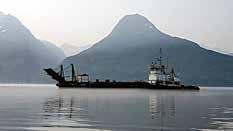

“There is a single production module which includes all of the essentials of production facilities, and it’s being fabricated in Anchorage with local labor and will be transported from the Port of Anchorage to the North Slope—the first single production module like this fabricated in Alaska in more than two decades.”
Construction began in 2023 and continues in 2024 with the pipeline and on-pad construction. Drilling is expected to start late this year, with first oil anticipated by early 2025. ConocoPhillips Alaska anticipates a peak rate of 20,000 barrels per day.
Lelarge says, “It’s pretty exciting to see this kind of work being done in Alaska, and it’s a great opportunity for the local economy. The way we think about this is that Nuna is another example of ConocoPhillips continuing to invest in Alaska and leveraging current infrastructure and using local labor.”
Meanwhile, back in the NPR-A, ConocoPhillips Alaska is eyeing a new project west of the Greater Mooses

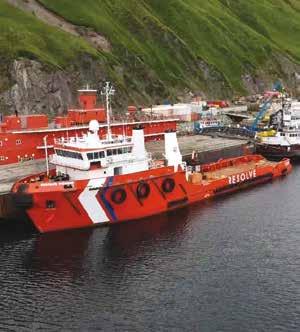
Greater Mooses Tooth 2, in production for two and a half years, contains eighteen wells so far. ConocoPhillips Alaska has five more planned for 2024, and the potential for additional wells at the site is being evaluated for 2025.
ConocoPhillips

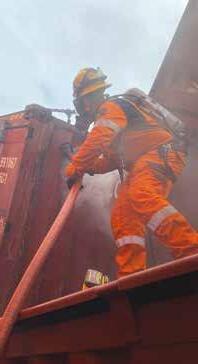

Tooth Unit. It’s called the Bear Tooth Unit, but the project name is Willow.
ConocoPhillips Alaska acquired the Willow leases in 1999, and after successful exploration, the permitting process began in 2018. The project underwent five years of regulatory review and environmental analysis as well as more than 215 days of public comment and twenty-five inperson public meetings in Anchorage, Fairbanks, Nuiqsut, Utqiaġvik, Atqasuk, and Anaktuvuk Pass. In December 2023, ConocoPhillips Alaska announced a final investment decision, approving the Willow project and funding construction.
Willow is expected to cost $7 billion to $7.5 billion to develop from 2024 to first oil, which is expected in 2029. Over its lifetime, Willow is expected to produce about 600 million barrels of oil, or about four GMT2s. “It’s the largest project in size and scale to be developed on the North Slope in more than twenty years,” says Lelarge.
Construction on the Willow project began last year during the 2023 ice road season, and it continues this






year, according to Lelarge, who says significant progress should be made in 2024, including the gravel road, pad, and pipeline construction. “We expect the operations center will be delivered in 2024, and the workload for Willow should remain steady for the next few years as we prepare for first oil in 2029,” he says.
Beyond Nuna and Willow, Lelarge says ConocoPhillips Alaska is excited to continue to develop other opportunities, including the Coyote Reservoir on the western side of the KRU as well as projects on the eastern side, focusing on the West Sak Reservoir.
“That’s the track record we have of adding new projects,” he says. “Development projects like Willow and Nuna and the other projects I mentioned really stimulate the economic growth in Alaska and generate taxes and revenue for state and local governments, and they contribute to strengthening our energy security in the country.”

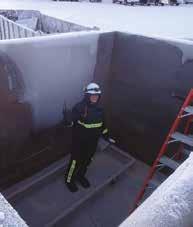
ConocoPhillips Alaska is somewhat unique, advancing new development on federal lands. Opening the oil frontier in NPR-A entails grappling with decision-making priorities in Washington, DC, that are different from the state government.
Moriarty recognizes that ConocoPhillips Alaska has had to struggle getting federal approval. “So it’s really rejuvenating to see contractors busier than they’ve been in some time,” she says. “It’s not only good for the industry but for the state and the local government of the North Slope Borough.” Moriarty notes that Santos and Hilcorp are also contributing to a recovery after the oil price crash of 2014 stalled investments.
Every oil and gas industry job supports fifteen additional jobs in Alaska, according to a study by McKinley Research Group. Pointing to that study, Lelarge says, “Our industry and all of the activity on the North Slope continue to be a dominant generator to the economic activity in Alaska. New projects like these assure us that the state of Alaska has a viable economic future.”

“With the people and the technology and the skills we have—and with a stable fiscal environment—we have to continue this trend of value creation for decades.”
Vincent Lelarge
Vice President of Alaska Asset Development
ConocoPhillips



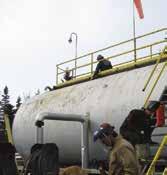


East side, west side, mid-channel, offshore, onshore, oil, natural gas, sometimes both… the variety of Cook Inlet fields is bewildering. Although the region contains more than twenty units on both state and federal leases, a dozen of them account for the bulk of production. Some are no longer producing; for example, Middle Ground Shoal (located between the Trading Bay and Kitchen Lights units) was the first offshore field in Cook Inlet in 1963, but its Baker, A, C, and Dillon platforms have been idle for years. The structures might be revived, however, for offshore wind energy. Clip these cards and shuffle them whichever way makes sense. Rank them by production of barrels of oil (bbl) or by billions of cubic feet (bcf) of gas. Order them by rookie year. Arrange them as a map. Get to know the longest-running petroleum province in Alaska that gave the industry a foothold and that continues to power the state’s population center.
Landowner: State/Federal
Operator: Hilcorp Alaska
First Production: 1963
Wells: 33
Oil Output (2023): -
Gas Output (2023): 12.1 BCF
Peak Production: 2004
Ownership Interest: 66% Chugach Electric Association
33% Hilcorp Alaska
The Beluga River gas field, a formation approximately 7.5 miles long by 2.5 miles wide, was discovered in 1962. It fuels the nearby power plant that is Anchorage’s main source of electricity. Hilcorp Alaska has plans to drill two J-pad wells in the Beluga River Unit and construct a mobile grind-andinject facility for treating and disposing of waste. Nearby, the Ivan River Unit produced 2.4 bcf from five wells last year.
Landowner: Federal
Operator: Hilcorp Alaska
First Production: 1972
Wells: 20
Oil Output (2023): 141K BBL
Gas Output (2023): 2.7 BCF
Peak Production: 1988
Ownership Interest: 100% Hilcorp Alaska
Nestled inside the boundaries of the Kenai National Wildlife Refuge, the Beaver Creek field in the Beaver Creek unit is connected by Hilcorp’s 12-inch diameter pipeline to the refinery in Nikiski. The gas field was discovered in 1967, and Marathon Oil operated it until Hilcorp took over in 2013. Taps the Beaver Creek oil pool and Beluga and Tyonek gas pools.
Landowner: State
Operator: BlueCrest Energy
First Production: 2007
Wells: 5
Oil Output (2023): 260K BBL
Gas Output (2023): 0.4 BCF
Peak Production: 2018
Ownership Interest: 100% Hilcorp Alaska
The field is better known by its unit name, Cosmopolitan. Discovered by Pioneer Natural Resources but idle for 2008 and 2009. Buccaneer took over in 2012, and then BlueCrest Energy gained control in 2014, deploying innovative “fishbone” extended reach wells from onshore. The oil reservoir is thought to lie under gas pockets not easily accessible from shore. The unit also includes the Starichkof field discovered by Pennzoil in 1967 but never developed.
Landowner: State
Operator: Hilcorp Alaska
First Production: 1967
Wells: 46
Oil Output (2023): 815K BBL
Gas Output (2023): 1.1 BCF
Peak Production: 1967
Ownership Interest: 100% Hilcorp Alaska
Discovered by Amoco in 1965 and put into production by Unocal in 1967. Hilcorp took over in 2011. Taps the Granite Point gas pool, Middle Kenai oil pool, and the Hemlock pool from the Bruce, Anna, and Granite Point platforms connected to the Granite Point tank farm on the edge of the Trading Bay State Game Refuge. Hilcorp Alaska proposed three new wells targeting the Tyonek formation.
Landowner: State
Operator: Furie Operating Alaska
First Production: 2015
Wells: 6
Oil Output (2023): -
Gas Output (2023): 3.6 BCF
Peak Production: 2017
Ownership Interest: 79% Cornucopia Oil and Gas 11% Furie Operating Alaska | 10% Other
The largest unit in the region by area, located about 10 miles north of Boulder Point near Nikiski. Shell drilled two wells in the mid-‘60s, to little avail. ARCO added two more wells in the early ‘90s, and ConocoPhillips drilled in the unit, too. Cornucopia acquired a majority working interest in 2010, and Furie Operating Alaska brought in the Spartan 151 jack-up rig and Kenai Offshore Ventures’ Endeavor rig to finally tap into the Beluga and Sterling gas pools. The Julius R platform is connected by 10-inch pipe to the East Foreland facility.
Landowner: State
Operator: Hilcorp Alaska
First Production: 1960
Wells: 5
Oil Output (2023): -
Gas Output (2023): 6.8 BCF
Peak Production: 1970
Ownership Interest: 100% Hilcorp Alaska
Across the mouth of the Kenai River from the Cannery Loop Gas Storage Station sits one of the state’s oldest producing natural gas fields. Unocal and Marathon started production, tapping the Sterling gas pool. Hilcorp has been in charge since 2013. The unit also contains thirty-three nonproducing wells.
Landowner: State
Operator: Hilcorp Alaska
First Production: 1969
Wells: 16
Oil Output (2023): -
Gas Output (2023): 12.3 BCF
Peak Production: 2001
Ownership Interest: 100% Hilcorp Alaska
Home to the Tyonek A platform, connected by a Harvest Alaska gas pipeline to West Cook Inlet; a Hilcorp pipeline doubles back to shore north of Nikiski. Phillips Petroleum first tapped the Tertiary gas pool. The most productive well, A-13, started in 1993 and quit in 2006. In the meantime, ConocoPhillips took over, and Hilcorp has operated the unit since 2016. Hilcorp proposed two new wells targeting Beluga sands.
Landowner: State
Operator: Hilcorp Alaska
First Production: 2003
Wells: 50
Oil Output (2023): -
Gas Output (2023): 14.3 BCF
Peak Production: 2006
Ownership Interest: 97.44% Hilcorp Alaska
2.56% Uncommitted
First tapped by Marathon in 1966 but idle until 2003, when it came online as the largest Cook Inlet gas discovery in twenty years. Offshore reservoirs tapped from onshore pads named Pearl, Paxton, Susan Dionne, Falls Creek, Kalotsa, and G. Oskoloff, which is the most productive. Acquired by Hilcorp in 2013. Hilcorp Alaska drilled three new development wells in the unit in 2023: Pearl 10, Pearl 11, and Paxton 12.
Landowner: Federal
Operator: Hilcorp Alaska
First Production: 1958
Wells: 53
Oil Output (2023): 267K BBL
Gas Output (2023): 2.6 BCF
Peak Production: 1967-68 (Oil) | 1992 (Gas)
Ownership Interest: 100% Hilcorp Alaska
Until 1957, explorers drilled 165 unsuccessful wells at the unit inside the Kenai National Wildlife Refuge. Then, in July of that year, Richfield’s oil strike proved that Alaska deserved a star on the US flag. A few weeks later, Chevron purchased a 50-percent interest in Richfield’s leases and became operator. Unocal was the operator in 2011 when Hilcorp took over. The Swanson River field is currently being blown down to recover as much remaining gas as possible.
Landowner: State
Operator: Cook Inlet Energy
First Production: 2001
Wells: 6
Oil Output (2023): 162K BBL
Gas Output (2023): -
Peak Production: 2003
Ownership Interest: 100% Cook Inlet Energy
Amoco first tapped the Tyonek gas pool in 1968, but the unit was idle until Forest Oil put it into production in 2001 with the Osprey platform, the first new Cook Inlet platform in fifteen years. Pacific Energy Resources took over in 2008 and then Cook Inlet Energy in 2009. Osprey is connected by an 8-inch gas pipeline to the Kustatan Production Facility at the tip of West Foreland.
Landowner: State
Operator: Cook Inlet Energy
First Production: 1991
Wells: 9
Oil Output (2023): 214K BBL
Gas Output (2023): -
Peak Production: 1994
Ownership Interest: 100% Cook Inlet Energy
Started by Steward Petroleum Company, joined by Forest Oil in 1993 and Forcenergy in 1995. By 2000, Forest Oil took over all active operations, then Pacific Energy Resources in 2008, then Cook Inlet Energy in 2009. Onshore wells near the West McArthur River Production Facility tap the shallow-water West McArthur River, Tyonek, and Hemlock oil pools.
Landowner: State
Operator: Hilcorp Alaska
First Production: 1965
Wells: 63
Oil Output (2023): 325K BBL
Gas Output (2023): 0.4 BCF
Peak Production: 1969 (Oil) | 1971 (Gas)
Ownership Interest: 100% Hilcorp Alaska
Discovered by Unocal and Texaco and operated by Unocal until Hilcorp took over in 2011. Platform Spark was most productive early on; currently, only the Monopod platform is producing from the Middle Kenai, Hemlock, and West Foreland pools. Another field in the unit, McArthur River, added 945,000 barrels of oil and 4.9 bcf of gas in 2023 from the Grayling, King Salmon, Dolly Varden, and Steelhead platforms. Steelhead was the first new Cook Inlet platform in eighteen years when it was installed in 1986. Pipelines connect all the platforms to the Trading Bay Production Facility just outside the Redoubt Bay critical habitat area.
















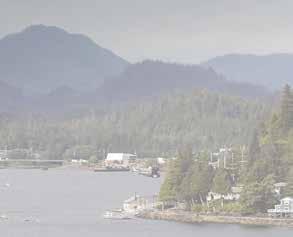


































by

Al aska’s relationship with oil began in 1902 when The English Company, soon renamed the Alaska Development Company, struck oil at Katalla, 47 miles southeast of Cordova. Katalla became a boom town, and a refinery was built in 1911, mainly supplying fuel to fishing vessels. A total of 154,000 barrels were produced over twenty years until Christmas Day 1933. A fire destroyed the Chilkat Oil Company refinery, and it was not rebuilt. Katalla disappeared from the map ten years later when the post office closed for good.
The history of oil in Alaska did not end there, of course. Discoveries in the ‘50s and ‘60s put the state’s economy on its present trajectory. The industry remains the state’s largest contributor to jobs and wages, employing up to one-third of Alaskans, directly or
By Amy Newman
indirectly, and oil revenue is the largest component of the state budget.
Despite the industry’s lengthy and undeniable impact, there was no coordinated effort to preserve and document that history, no central location to store and share it.
Thus, the Alaska Oil & Gas Historical Society (AKOGHS) was born. Formalized in November 2022, the society’s goal is to collect, preserve, and share the history of Alaska’s oil and gas industry through archival collections, oral histories, exhibitions, and educational programs.
“There’s already a lot out there about Alaska’s oil and gas history that’s cataloged or captured in pictures or print by all of the large companies,” says the society’s co-founder, Rebecca Logan. “We’re really interested in complementing what’s out there with
narratives of the people who worked in the industry and also making everything more readily available and in the forefront, so people are regularly reminded of it.”
Logan, the CEO of the Alaska Support Industry Alliance, got the idea for an oil and gas museum during a 2011 trip to Norway. The Scandinavian country is the eighth largest crude oil exporter and fourth largest exporter of natural gas in the world, and oil and gas is its single largest industry, according to the International Trade Administration.
What Logan saw made her recognize what Alaska was missing. “I saw a really fabulous oil and gas museum that, every day, there were kids pulling up non-stop and learning
about Norway’s oil and gas history,” she says. “We were the only working state in the country that didn’t have a [historical] society or museum.”
Or so she thought. As she explored the idea, she found out that was only partially true.
“I learned there was an oil and gas museum in Gustavus, in Southeast Alaska,” she says. The Gustavus Dray store and Petroleum Museum has a pre-World War II replica Mobil service station with a working 1937 “Wayne 60” gasoline pump. But, on top of its remote location, the Gustavus museum barely covered the industry’s extensive history in the state.
Logan says industry insiders discussed the idea of a museum for years, but nothing moved beyond informal talks.
Kara Moriarty, president and CEO of the Alaska Oil & Gas Association, became convinced that Alaska needed to memorialize its oil and gas history when she spoke at a Canadian conference several years ago. Moriarty was struck by how prominently the provinces and territories she traveled through displayed their oil and gas heritage, leaving no question as to the industry’s economic importance. It was a sharp contrast to Anchorage, she says.
“You step off the plane in Anchorage and there are a few banners about ConocoPhillips or BP, back when BP was here. But otherwise, you would have no idea the oil and gas industry has been such an integral part of the state’s history,” Moriarty says. “So when [Rebecca] called me and said, ‘I’ve been made aware that other states have museums and what do you think about it?’ Of course, I thought this sounded like an amazing idea and of course, we should do it.”
In 2015, with the industry coming off its biggest revenue year, talks became more formal, and the Alliance began searching for a museum site. “And then oil prices tanked, and we put a hold on that effort,” Logan says.
In 2022, discussions began anew. “We were starting to lose people, and that just gave us a sense of urgency,” she says. “And we had a really fabulous opportunity to record the oral histories
of people who are pioneers in the industry. That sense of urgency was enough to get us from talking about it to formalizing it.”
What was formalized was the AKOGHS. Logan incorporated the society along with Joe Mathis, a founding member of the Alliance, and Brad Chastain, a long-time industry member. They assembled a sixmember volunteer board of directors, which includes Mathis, Chastain, Moriarty, Dave Haugen, James Palmer, and Dave Norton. The AKOGHS filed
articles of incorporation in November 2022 and received 501(c)(3) status from the IRS in January 2023.
“This concept and idea wouldn’t have gotten off the ground without Rebecca’s leadership and vision,” Moriarty says. “She’s not technically a board member, but she’s been the real driving force. Not that we all don’t think it’s a great idea, but she really deserves the credit.”
Preserving the Past AKOGHS’ long-term goal, which

From 8 hours up to 200 hours for utility and mining applications
Low cost — Offers a lower levelized cost than currently available technology — CapEx, OpEx and end-of-life.
Scalable — No topographical or geologic dependencies; can be built anywhere with a fully domestic supply chain.
Flexible — Modular solution that can uniquely serve high power needs at both medium and longer GWh durations (8–200+ hours). Provides grid inertia and other ancillary services.

Longest asset life —
Unlike lithium or chemical batteries, power generation equipment has no loss in capacity or capability over time.
Sustainable — No chemical, fire or safety risks; Long asset operational lifespan (50 years+); low carbon footprint and fully recyclable at end-of-life.
Proven Technology
Currently Being Deployed in First Commercial Application
www.westinghousenuclear.com



Logan estimates will take five to seven years to realize, is to build a museum to serve as a repository of photos, videos, memorabilia, books, and other materials that document and illustrate the history and evolution of the oil and gas industry in Alaska. Like the Norwegian museum that piqued Logan’s interest more than a decade ago, the AKOGHS envisions busloads of school children walking through the museum’s doors.
“One thing I know that everybody wants is a place where Alaska school children can come and learn about the oil and gas industry because it’s so out of sight for them,” Logan says. “It’s either a drill right in the inlet or a drill rig on the North Slope, and nobody really sees the industry unless you drive along the Pipeline.”
AKOGHS’ work toward the museum is guided by an 800-page document from the American Association of Museums. Logan says one goal for 2024 is to expand both the board of directors and the committee working on the museum, whose initial focus is on identifying and engaging stakeholders, creating a vision for the museum, and determining costs.
With no physical location to store items, the AKOGHS is not actively soliciting donations yet, but Logan says that hasn’t stopped people who have learned about plans for a museum from reaching out.
“Almost every day, I have someone who says, ‘When are we going to have a museum? I have so much stuff,’” she says. “I had two huge boxes sent from Pennsylvania, somebody I didn’t even know, whose dad had been a geologist in the











early 1950s, with six rolls of 8mm film with a narrative to go with it of that geologic work. People are hearing about it, and it’s just an exciting thing to be a part of.”
Some of the history AKOGHS is uncovering is new even to Logan. She had no idea, she says, that ARCO hired Olympic athlete Wilma Rudolph—who in 1960 became the first American sprinter to win three gold medals—to help design recreational facilities for its workers at Prudhoe Bay.
“There is so much good stuff like that,” she says. “It’s fun, and, of course, those are the stories that people love to hear.”
Not every story in the oil and gas industry’s past is positive, but Moriarty says the museum will provide a “full capturing” of its history, positive and negative. “We know we’re going to talk about and have some type of [exhibit] at the museum on the Exxon Valdez oil spill,” she says. “We’re not going to shy away from some of the points in our history that we would have preferred never to have happened, because they did. But we can look at what we learned from them and how has the industry changed because of tho se types of events.”
Central to the AKOGHS’ mission is capturing the oral histories of the people behind the industry.
“The focus is really, to me, the people, because without the people, this industry wouldn’t be successful back then; it wouldn’t be successful today,” Moriarty says. “And without the people helping to shape policy, we—the oil and gas
In 1960, Wilma Rudolph won the 100-meter dash in Rome. In 1983, she consulted on Prudhoe Bay recreational facilities.
IanDagnall Computing | Alamy

Attorneys from Dorsey & Whitney are deeply engaged in helping mining, energy, and natural resources clients across the full lifecycle of exploration, development, production and beyond, providing timely and effective counsel to companies in Alaska and around the world. We provide comprehensive representation, helping clients with everything from transactions and financing to litigation, regulatory, and environmental compliance.
Best Lawyers 2024 (BL Rankings LLC)
Chambers Global 2023




industry—wouldn’t have been such an integral part of t he state’s economy.”
AKOGHS is compiling an “endless” list of current and former industry workers and prioritizing recording the oral histories of older pioneers, Logan says. The society also attends industry events to capture stories tied to specific historical points. For example, 2024 marks the 50th anniversary of the start of construction on the Dalton Highway haul road, so the Alliance had a camera crew at its March Meet Alaska conference to record stories from people who worked on the road.
“We’re really focused on the oral histories right now,” Logan says, adding that the goal is to record at least forty. “We did fifteen of those last year, which was wonderful because of what we got out of them. And two of them—one in their late 80s and one in their early 90s—passed away after we recorded them, which is exactly wh y we’re doing this.”
The society is keeping those oral histories mostly private so far, highlighting snippets at industry presentations, pop-up exhibits, and the AKOGHS website. Stories include reminiscences from Ted Stagg, who worked on the discovery well at Prudhoe Bay and provided an engineer’s perspective, and Jesse Wade, who began working in the industry when he was 20 years old.
“He had a lot of stories to tell, [including] one about being the drill rig hand sent down into the discovery well at Prudhoe Bay, with a rope around his waist and a five-gallon bucket, to send up mud and broken pieces of the drill that hadn’t ever been used with perm afrost,” Logan says.
Some stories aren’t directly tied to oil and gas production but drive home the idea that people are at the heart of the industry, like the story about a production manager at the Endicott field who loved music so much he brought in a piano to play.
“That’s what people remember, are stories,” Moriarty says. “They aren’t going to remember facts and figures per se, but who were the people at the Prudhoe Bay lease sale that made that so unique. I thi nk that’s exciting.”
“We’re really interested in complementing what’s out there with narratives of the people who worked in the industry and also making
everything

more readily
available
and in the forefront, so people are regularly reminded of it.”

CEO
Alaska Support Industry Alliance
The AKOGHS’ founding members campaign, which provides startup funds for the organization, will run for another year, Logan says, after which it will shift to an annual membership campaign.
Outside of that, Moriarty says the board’s focus for 2024 is capturing oral histories, increasing membership, creating a broad communication plan, and working on a collection policy for accepting donated items.
“I just think there’s a lot of really fun and exciting opportunities for the historical society,” Moriarty says. “I envision twenty years from now, when my grandkids are going on a school trip, that it’s to the historical society museum so they can learn the history of the oil and gas industry as part of what makes Alaska so great.”










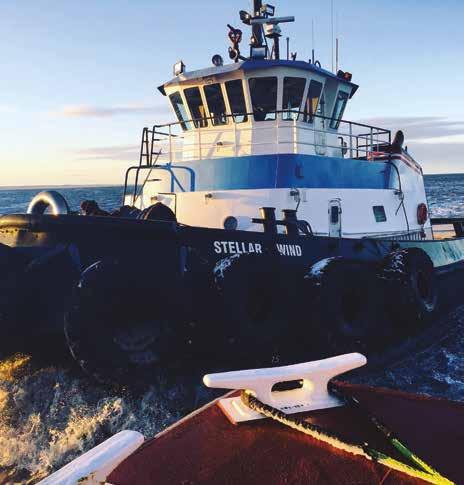

Alaska software to untangle oil field complexity
By Rachael Kvapil

Badami, an oil field about 25 miles east of Prudhoe Bay, was idle for five years in the early 2000s until Savant Alaska, in partnership with a wholly owned subsidiary of Arctic Slope Regional Corporation, revived it. The producer took over from BP Exploration Alaska in 2011 and embarked on an effort to find operational efficiencies.
Although relatively young as Alaska oil fields go, Badami’s operations had accumulated a crust of suboptimal solutions. Badami utilized more than sixty different technologies to support the management and execution of field operations, mainly enterprise-grade systems that were immensely powerful at the office in Anchorage and at the corporate level. However, the systems required extensive and ongoing training for use in the field and were often considered too complex and unwieldy for day-to-day use.
Field workers improvised more than 1,000 workarounds, commonly referred to as “shadow systems and tools.” Unseen by central IT departments, these field solutions

“Skilled personnel—and their need to leverage technology specifically designed to enhance their ability to execute upon and manage their work in the field—will be required regardless of which field they work in.”
Michael D’Iorio Vice President of Industry Solu tions, TRUApp Energy
Remote facilities are the most iconic images of oil and gas in Alaska, yet the industry also includes high-tech development at cozy workshops in Anchorage. TRUApp Energy

“It provides the organizational capability for hundreds or thousands of field personnel, across dozens of departments and fields, and tens of thousands of tasks, to use one system to digitally document and carry out the tasks assigned to their specific role.”
Michael
included disconnected spreadsheets, databases, shared drives, binders, ad-hoc reports, and other hacks to manage day-to-day operations.
To untangle the Gordian knot of complexity, Savant Alaska partnered with Anchorage-based managed services provider and tech developer Tex R Us. The company has a portfolio of clients ranging from ACE Air Cargo and Cornerstone General Contractors to oil and gas companies such as Little Red Services, BlueCrest Energy, and Caelus Energy Alaska.
The collaboration between Savant and Tex R Us led to the formation of a sister company, TRUApp Energy, and its eponymous software application that supports oil and gas producers in their ongoing efforts to make energy secure, abundant, and affordable.
TRUApp Energy is an oil and gas field co-operating platform. It centralizes the orchestration and enablement of digital resources that drive the daily
execution, management, and safety of work in the field, explains Michael D’Iorio, vice president of industry solutions for TRUApp Energy. He says the app is a proven solution to reduce non-productive time by lowering the number of man-hours needed to safely carry out tasks. The app is available to clients on-premises or via a secure and private cloud system and is accessible to users via a browser or tablet.
TRUApp Energy provides department leaders with the data and information they need to plan, prioritize, analyze, and distribute work. The developers call this the “orchestration layer,” which integrates with the app’s “enablement layer” to support the execution of work. Enablement also ensures that department specialists have the documentation, training, and materials they need at the point of performance. Users have a customizable dashboard to review tasks, work orders, materials, safety alerts, and other critical information.
“It provides the organizational capability for hundreds or thousands
President of Industry Solu tions, TRUApp Energy
D’Iorio Vice
of field personnel, across dozens of departments and fields, and tens of thousands of tasks, to use one system to digitally document and carry out the tasks assigned to their specific role,” says D’Iorio.
Data-rich technologies have always assisted with capital-intensive oil and gas exploration. However, in the early days of TRUApp Energy’s development, Savant and Tex R Us decided to focus on creating a solution that increased efficiencies in aboveground operations. Developers based this decision on the discovery that surface technologies had been lagging subsurface technologies for decades.
“The labor costs associated with surface operations presented an untapped opportunity, as the field makes up a significant percentage of an oil and gas producer’s ongoing operating costs,” says D’Iorio.
The path to automating and integrating workflows within a
centralized technology platform required developers to drill into core departmental functions necessary to run field operations on the North Slope and then identify which functions and processes were ripe for optimization. Working side by side with experienced specialists, Tex R Us started by analyzing existing surface technologies used to run Badami. D’Iorio says the methodical analysis resulted in mapping core components of field operations and affiliated technology.
“None of these enterprise systems spoke with one another out of the box,” says D’Iorio. “As a result, they required another layer of peripheral technology to cobble this data and communication capability together.”
This discovery reinforced TRUApp Energy’s initial challenge: creating a “less is more” approach to the number of technologies required for use and management by field personnel.
Over the next two years, developers continued to analyze, restructure, optimize, and digitally house workflows, resulting in an integrated oil and gas surface operational model. This centralized platform fundamentally altered the work dynamics, cost structure, safety, and profitability of Savant’s operations at the Badami field.
Not long after Savant was bought by a new owner in 2015, TRUApp Energy acquired full ownership of its flagship software, though the app remains the core technology at Badami. In the following decade, TRUApp Energy operated largely behind the scenes with its partners and expanded its presence on the North Slope and Cook Inlet. The company invested heavily in additional research to elevate TRUApp Energy’s capabilities to support larger oil and gas producers.
D’Iorio says TRUApp Energy’s largest client is Eni, the Italian supermajor that operates multiple fields on the Slope. Working with that client for more than four years has resulted in a reduction of operating costs across departments ranging from maintenance and asset integrity, materials management, and health, safety and environmental management to production, camp maintenance, and training and procedures management.
“With hundreds of TRUApp users in the field for this one client, the platform actively manages tens of thousands of work orders, tasks, pieces of equipment, and materials each year across multiple assets and locations,” D’Iorio says. “In doing so, we’ve become a valued partner and cornerstone of their approach to field operations. We’ve proven our ability to support them on the Slope.”
For producers with complex facilities, the breadth and depth of orchestration and enablement requirements demand
TRUApp Energy’s integrated digital workflows and automation, D’Iorio says. Past reliance on paper, Post-it notes, filing cabinets, and binders can’t meet demands for safety, compliance, regulation, and cost control. Likewise, D’Iorio finds the widespread use of disconnected shadow systems, which require constant manual and redundant data entry to stay up to date, to be inefficient, costly, and risky. In their place, D’Iorio says efficiencies across field operations by standardizing the capture and organization of

LIFEMED


real-time and historical data unlock TRUApp Energy’s ability to support executive decision-making.
There are five key areas where TRUApp Energy’s integrated platform shines for oil and gas leaders. A costcontrol playbook can reduce expenses by increasing labor efficiencies and eliminating unseen costs that accumulate within manual system workarounds. Connecting field operators, back-office support services, and corporate decision-makers also leads to greater transparency and cooperation by harmonizing these sites with a single source of shared data. In support of mergers and acquisitions, TRUApp Energy establishes greater cost controls by capturing real-time field costs and projections affiliated with labor, materials, equipment, safety, and compliance. Growthminded producers can leverage this vertical software platform during acquisition analysis, as well as in the exit modeling and valuation phases. Likewise, talent attraction, team assembly, and retention become easier with a built-in learning management system that streamlines the onboarding and ongoing certification
processes. Finally, operational audits are more manageable, as TRUApp Energy centrally captures and organizes data and presents detailed information chronologically in fully customizable reports.
Larry Johnson, maintenance team lead for Savant Alaska, says TRUApp Energy has become a powerful tool for field operators. He says turbine uptime rates increased from 62 percent to about 98 percent. Likewise, compressors and other large pieces of equipment have increased uptime rates to almost 100 percent because the app allows crews to keep track of preventative maintenance. Before TRUApp Energy, failure rates on compressors were in the 50 percent to 60 percent range.
“Our uptime rate is being noted by other companies, even bigger companies,” says Johnson. “Using the app keeps us on schedule, tracks our hours of use, and tells us when it’s time to set up the annuals and to change the oils or filters.”
D’Iorio says producers have a fiduciary responsibility to shareholders and to local communities to operate as efficiently and safely as possible from an environmental perspective. TRUApp Energy is well-versed in supporting
strict environmental protection regulations. By using TRUApp Energy, he says producers are no longer at risk of losing crucial operational data that was once siloed in shadow systems or on paper, as institutional knowledge of facilities, equipment, and specialists is maintained and organized in a single, secure location.
“When you look at the execution and management of work through this lens of integration, standardization, and control,” says D’Iorio, “the far-ranging implications upon safety, personnel, compliance, and profitability become clear.”
Given all that the platform can manage, D’Iorio says it’s still important to differentiate what TRUApp Energy is versus what it is not. First, TRUApp Energy is not an accounting system. Instead, it acts as a subledger, feeding a producer’s accounting system with details of field costs that weren’t available before. Second, TRUApp Energy is not designed to replace legacy enterprise resource planning software essential for project management, asset tracking, or sophisticated solutions like corrosion management. TRUApp
Energy starts where these systems stop: at the execution of field work. It was designed to complement and sharpen these enterprisegrade, specialized systems with its work execution data set.
From an evolutionary perspective, TRUApp Energy plans to continue working with North Slope producers to unlock new operational efficiencies. Overall, the goal is to become the goto field co-operating platform across a portfolio of field assets from the North Slope and beyond, including expansion into other energy types and the industrial sector.
“It’s all very introductory at this point,” says D’Iorio. “But what is clear in these talks are the things that won’t change across energy types and other industries. In some capacity, skilled personnel—and their need to leverage technology specifically designed to enhance their ability to execute upon and manage their work in the field— will be required regardless of which field they work in.” D’Iorio adds that the collective intelligence of field specialists should be cultivated organizationally

to make energy more secure and affordable, so a single platform makes sense versus ungovernable, disconnected shadow systems.
D’Iorio says the problems TRUApp Energy solves are embedded in a broad array of industries. As TRUApp Energy grows and changes, developers will adapt its design for other energy sources as well. At its base, TRUApp Energy simplifies and automates operational complexity in assetintensive industrial operations. In this regard, D’Iorio considers upstream oil and gas as the first phase of TRUApp Energy’s product roadmap.
With twenty-five years of involvement in the oil and gas industry within Alaska, D’Iorio believes TRUApp Energy and Tex R Us have gained a depth of understanding of the energy and technology landscape. While its flagship software has already proven effective for major clients, the team feels there is additional work that could lead to TRUApp Energy becoming the standard for producers to safely manage field operations on the Slope and beyond for many years to come.

Invest in Alaska’s future with environmental services tailored to the most challenging needs, from thermal recycling to glycol recovery. As a global sustainability leader and Alaska’s premier recycler, we deliver cost-effective, sustainable solutions. Call 833.246.3367 or visit RepublicServices.com/ES to learn more.
“Our uptime rate is being noted by other companies, even bigger companies… Using the app keeps us on schedule, tracks our hours of use, and tells us when it’s time to set up the annuals and to change the oils or filters.”

Our locations:
• Anchorage
• Fairbanks
• Kenai
• Moose Creek
• Palmer
• Prudhoe Bay

By Dimitra Lavrakas
Th irteen miles south of Utqiaġvik, the Walakpa gas field sits near Walakpa Lagoon, site of the 1935 plane crash that killed world-famous aviator Wiley Post and beloved humorist Will Rogers. To the east of Alaska’s northernmost town lie two more resources, the East Barrow and South Barrow gas fields.
The federal government conveyed the subsurface estate of those fields to the North Slope Borough in 1984, enabling the municipal government to explore and develop a local energy supply.
Cheaper than what is charged for potable water, natural gas heats homes and runs turbines that generate electricity, which the member-owned Barrow Utilities & Electric Cooperative, Inc. (BUECI) sells at a relatively reasonable rate to residents, a rate many equally remote villages might envy.
Just about everything in the city runs on gas from the nearby fields. A network of crisscrossing gas lines heat homes at a far cost lower than oil-burning boilers, and BUECI has turned the gas into something even more useful and environmentally friendly: it operates a station that fuels vehicles with compressed natural gas (CNG).
“BUECI has vehicles that run on CNG,” says BUECI General Manager Timothy Russell. The fleet refills at a tap just north of the city proper.
The lone public filling station puts Utqiaġvik’s CNG capacity on par with Anchorage, a city with nearly sixty times the population. Anchorage likewise has only one CNG station, installed by equipment dealer Ditch Witch at its shop near Tudor Road and Minnesota Drive. That is, until recently; the

Barrow Utilities & Electric Cooperative, Inc. taps nearby natural gas fields to provide heat and power in Utqiaġvik.



We’re continuing our 63-year history of delivering natural gas, reliably and affordably, even as we face potential challenges in the years ahead. That’s why we’re proactively preparing now so we’ll be ready and able to serve our customers no matter what the future brings.
Our dedicated team is looking at every possible solution to ensure that we can deliver reliable natural gas to our customers today, tomorrow, and for the next generation.



A Norgasco pickup truck burns CNG, and sister company
Alaska CNG supplies tube trailers full of fuel to Great Bear Pantheon’s Alkaid No. 2 wellsite, where equipment is powered by gas associated with oil drilling or gas that is trucked in when drilling is idle.

station was damaged and taken offline. BUECI took over the Ditch Witch station and is looking for a new owner.
The setback from one station to none illustrates how far CNG has to go as a vehicle fuel. Even in Utqiaġvik, few vehicles apart from the BUECI fleet use locally produced CNG; drivers buy imported gasoline at the town’s lone service station operated by Eskimos, Inc.
CNG is a fuel still waiting for its time in the spotlight.
To fit inside a vehicle’s fuel tank, CNG is compressed to less than 1 percent of its room-temperature volume. Typical tank pressures of 3,000 to 3,600 pounds per square inch (psi) compare to household natural gas regulated to less than 1 psi. Even inside utility pipes, pressure is typically no more than 60 psi.
According to engine maker Cummins, about 175,000 vehicles in the United States use CNG, mostly for heavy- and medium-duty applications such as freight hauling.
A decade ago, the Alaska Department of Transportation and Public Facilities reported a “handful” of cars and one school bus operated by the Municipality of Anchorage used CNG. (The report on alternative fuels lumped them
with Toyota Priuses, when gas-electric hybrids were relatively rare.) It noted that an engineer in Palmer installed a CNG facility at his home and helped the Alaska Railroad convert three trucks.
However, the report found that, even when natural gas was plentiful across Southcentral, market concerns about retrofits and training limited CNG’s wider use. “Both public fleet managers and private residents are in an early adoption stage and have not reached the critical demand levels needed” to make CNG a common alternative, the report concluded.
That was also the view of industry expert Larry Persily, writing in 2011 (when he was the federal coordinator for marketing North Slope gas) that four roadblocks stand in the way of widespread CNG adoption. The vehicles cost more (although CNG itself is cheaper than the gasoline equivalent); CNG tanks occupy more trunk space; range is limited; and refueling options are sparse. “These barriers mean that converts to compressed natural gas vehicles for now likely will remain operators of diesel or gas-guzzling heavy-duty fleets—such as city or school buses, delivery or garbage trucks—whose vehicles can return to a central yard for refueling each day, or individuals with such deep commitment
to curbing greenhouse gas emissions that they will spend the extra money required,” Persily wrote.
In the decade-plus since, little has changed—but some are still striving.
Alaska CNG, a sister company of North Slope utility Norgasco, is firmly established as a CNG distributor.
In 2022, Alaska CNG began delivering gas from Prudhoe Bay to a development wellsite along the Dalton Highway. Replacing diesel with CNG for power generation and well support operations provided a 50 percent reduction in carbon emissions.
Alaska CNG uses high-pressure tube trailers towed by eighteen wheelers, the trucks themselves powered by CNG. Both Alaska CNG and Norgasco also use CNG to fuel their smaller vehicles.
“Moving CNG by tube trailers costs more than by pipeline but is still much cheaper than diesel. The tube trailers make sense until the demand is sufficient and permanent so it can justify a pipeline supply,” says Alaska CNG Chairman and CEO Ray Latchem. “Smaller vehicles are better.”
Latchem has been on the Slope since the ‘70s, so he knows what he’s talking about. He developed Norgasco in the ‘80s as Alaska’s third gas distribution

company (after Enstar and BUECI). In the ‘90s, he developed Fairbanks Natural Gas, now part of boroughowned Interior Gas Utility. As part of that supply chain, Latchem built Alaska’s first small-scale plant for liquifying natural gas at Point McKenzie. After selling Fairbanks Natural Gas, he developed another small-scale plant in Arizona to serve customers in Arizona, California, and Mexico.
When Alaska CNG received its CNGpowered Kenworth T800 in 2022, the company aimed to be a model for other haulers by demonstrating how North Slope gas, mainly a byproduct of oil production, could be put to in-state use. Fortunately, a customer, Great Bear Pantheon, has a road-accessible drill site named Alkaid No. 2.
“Alkaid is 16 miles south of Prudhoe Bay,” Latchem says. “The oil they produced from well testing contains ‘associated gas’ that would normally be flared. Great Bear installed gas-fired turbine generators and used some of their produced gas as fuel when they were testing the well, and when they weren’t testing the well, they used CNG from Deadhorse.”
It was a good deal, he says. The price of natural gas has been consistently equivalent to $2.50 per gallon of gasoline for decades, while gasoline

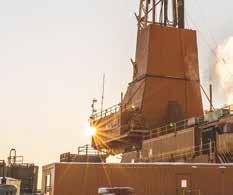






“Moving CNG by tube trailers costs more than by pipeline but is still much cheaper than diesel. The tube trailers make sense until the demand is sufficient and permanent so it can justify a pipeline supply.”
Ray Latchem Chairman and CEO, Alaska CNG
and diesel prices have fluctuated wildly. Further cost savings come from CNG’s naturally low nitrogen oxide emissions. New regulations for diesel engines require cutting those emissions by 90 percent, and the scrubbers to achieve that are expensive, but CNG engines don’t need them.
With those advantages, Latchem expects to grow Alaska CNG’s customer base beyond Great Bear Pantheon. “We hope to repeat it at the DOT’s [Alaska Department of Transportation and Public Facilities] Sag River maintenance facility and camp about 100 miles south of Deadhorse, and also the Toolik Field Station 30 miles beyond Sag River Station.”
In addition to the technological switch, converting to CNG is a mental hurdle. Alaska CNG has heard from
customers wary of trying a relatively new fuel. Truckers are accustomed to handling liquid fuels, but CNG takes getting used to. Obstacles to adoption include not just the startup costs of procuring new rolling stock but the lack of infrastructure along the road. Those factors could sufficiently explain why CNG is relegated to a niche fuel for fleets with central maintenance yards.
The Fairbanks North Star Borough is completing a new transit facility for its bus fleet this spring, and CNG is part of the design. The borough received almost $2.5 million in 2022 from the Federal Transit Administration for CNG buses and vans through a low-and-no-emission grant program in the Infrastructure Investment and Jobs Act of 2021.
Air quality is the major draw for CNG in Fairbanks, given the city’s notorious particulate pollution. Borough Mayor Bryce Ward called the federal grant
“a massive step in the right direction” for the conversion to environmentally friendly fuel alternatives. Additionally, using natural gas for transportation increases overall demand for the resource in the Fairbanks area, as Interior Gas Utility switches from trucking liquified natural gas from Point MacKenzie to sourcing gas from the North Slope instead.
“I am pleased that everything is coming together in great timing with the buildout of the borough’s new transit facility,” said Ward upon receiving the grant. Construction hit some snags with securing parts for the CNG refueling station, but the garage is on target for completion.
Ward says Fairbanks will start running the new buses this summer. And when they complete their routes, each day they’ll be refueled with compressed natural gas.

At Santos, we are proud to develop the world-class Pikka Project on the North Slope. Phase 1 will develop about 400 million barrels from a single drill site with first oil expected in 2026. And we are even prouder that our interest in Pikka will be net-zero on Scope 1 & 2 emissions!
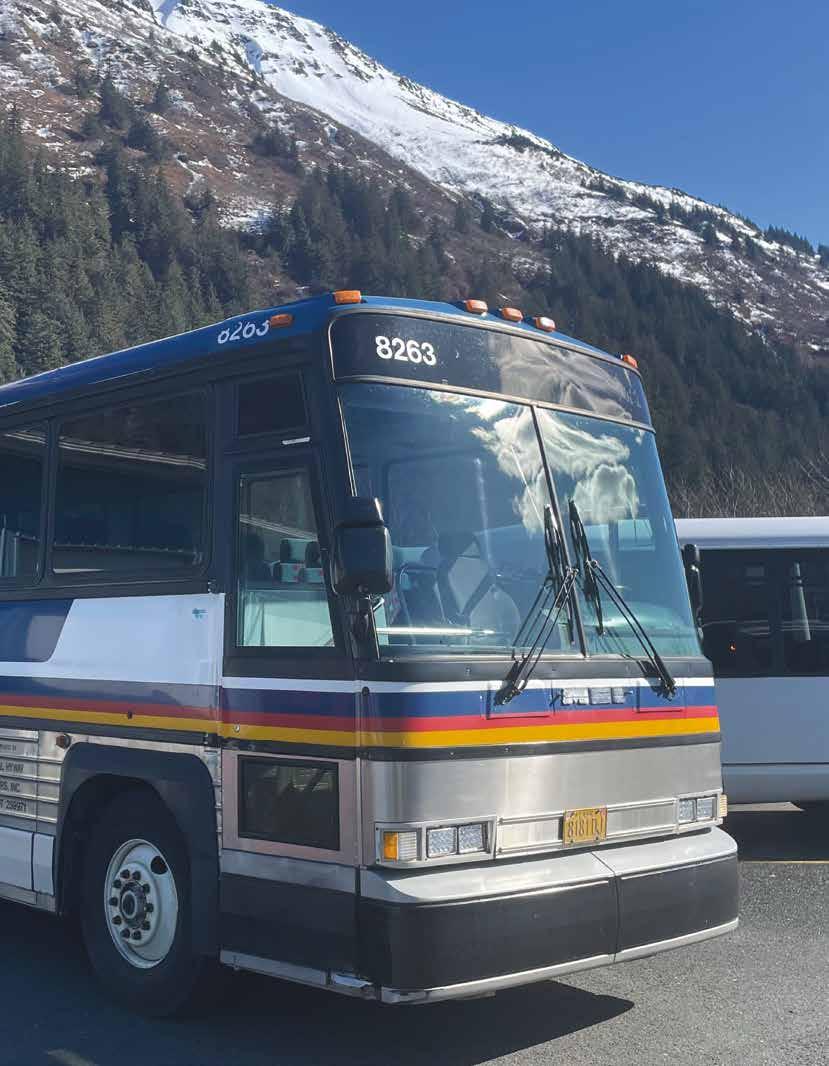
By Terri Marshall
Wa ste oil need not go to waste. By definition, then, it’s not a waste product but a useful material.
“Technically, we don’t like to call it waste oil,” says David Shaw of Nenana Heating Services Inc. “Used oil is the preferred term.”
Nenana Heating Services is the exclusive Alaska dealer of Clean Burn furnaces and boilers powered by used oil. The company also sells recycling rigs that hold 250 gallons per unit. “The crank oil that comes out of an engine is cleaned and converted to be used as heat ing oil,” Shaw says.
Normal use of oil—such as for lubrication of vehicles, lawnmowers, or other machines—leads to impurities such as chemicals, dirt, metal scraps, or water. Once oil is mixed with these impurities, it eventually loses its effectiveness, so the oil must be replaced.
While oil attracts impurities with prolonged use, the hydrocarbon molecules never wear out, which means it still contains energy. The process of recycling used oil includes de-asphalting, distillation, filtering, and water extraction. Once this process is completed, used oil can be reused as lubricant, turned into hydraulic fluid, or polymerized as plastic.
Or it can be combusted as fuel in heaters or engines.
In search of new ways to decrease emissions from tour buses that carry cruise ship passengers ashore in Juneau, Holland America Princess began using biodiesel made from cooking oil discarded by local restaurants. Used restaurant oil is one of the ingredients for biodiesel, mixed about 10 percent with virgin diesel.
Carnival Corporation’s shore-side operations for Holland America Line and Princess Cruises in Alaska involve an extensive fleet—not just the luxury
“As a state distributor for Clean Burn for almost forty years, I firmly believe (from what I’ve seen) they have mastered this… They’ve got the best units out there.”
David Shaw President, Nenana Heating Services Inc.


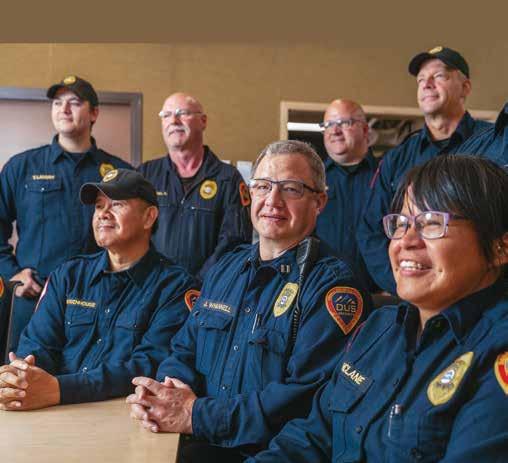
“This is more about doing the right thing for Alaska than anything else… We have tour buses and vehicles that can accept biodiesel, and I am hopeful we can expand that program into each one.”
Bill Hagevig Alaska and Yukon Division Manager Holland America Princess
Bill Hagevig of Juneau, the Alaska and Yukon division manager of Holland America Princess, worked with a local supplier to devise an alternative. Hagevig’s idea was to tap into the used cooking oil from the company’s own ships to power a motorcoach.
Kitchens on board Discovery Princess were modified to isolate cooking oil for use as biofuel. The process required developing proper offloading procedures in Juneau’s port, testing the oil, and working with a biodiesel supply company.
“This is more about doing the right thing for Alaska than anything else,” says Hagevig. “We have tour buses and vehicles that can accept biodiesel, and I am hopeful we can expand that program into each one.”
The program has paused in Juneau since the local partner moved away, but the cruise line is hoping another business will step in.
Turning cooking waste into highperformance fuel dates to the 19th century when Rudolf Diesel—the man who gave the diesel engine its name— started experimenting with plant oils. Initially using peanut oil to create an internal combustion engine, he received a patent for an oil-based engine. However, when petroleum-based fuels became readily available and affordable, the use of renewable fuel faded away.
Later, a focus on sustainability increased interest in renewable fuels.
interest in recycling dates to the ‘70s energy crisis. During this challenging time, businessman and inventor Ben Smoker developed a way to safely and economically convert used oil into heating oil. Working with a steel company in Lancaster County, Pennsylvania, Smoker had already patented several energy-related products. His new approach provided a money-saving and eco-friendly disposal option for auto repair shops and other facilities with too much used oil on their hands.
Smoker started Clean Burn, a company that became the market leader in multi-oil furnaces.
The first Clean Burn waste oil furnaces in 1979 marked a refinement of a new technology: waste oil combustion for heat recovery in a selfcontained, efficient, and affordable system. Clean Burn offers numerous models ranging from 140,000 to 500,000 British thermal units per hour. The manufacturer’s used-oil boilers are recommended for applications such as car and truck washes, radiant floor heat, space heat, snow and ice melting, and industrial processes.
“As a state distributor for Clean Burn for almost forty years, I firmly believe (from what I’ve seen) they have mastered this,” says Shaw. “They’ve got the best units out there.”
liners at sea but motorcoaches on the roads. In 2018, Carnival Corporation and its brands began pioneering fuel technologies in an effort to be better neighbors in communities where cruise ships make port calls. Not only can biodiesel reduce pollution emissions, but it diverts waste oil that would otherwise be managed locally.
Unfortunately, when the COVID-19 pandemic arrived, local restaurants experienced a significant reduction in customers. Cruise ships were absent for 2020 and 2021, too, but the return to business in 2022 demanded a new supply of used cooking oil.
The Energy Independence Security Act of 2007 set benchmarks for renewable fuel use in the US, focusing on a goal of reducing reliance on traditional fuel sources. When production levels were established, the renewable fuel market began to explode, peaking in 2011. More cooking oil recycling businesses began operations to help meet demand, and with federal mandates continuing to rise each year, the market will continue to thrive.
In 2010, waste management company Alaska Waste opened Alaska's first large-scale biodiesel plant. The plant produces 250,000 gallons of biodiesel annually from vegetable oil gathered at local restaurants. Alaska Waste plans to fuel up to 20 percent of its vehicles with biodiesel.
For petroleum-based used oil,
The energy content of 2 gallons of used oil approximately equals the electricity consumed by a typical household for twenty-four hours, or about 36 kWh. By recycling used oil, businesses not only save on disposal and environmental liability costs but also on overall heating expenses.
Shops generating used lubricating oil that is sent off for recycling are regulated by the US Environmental Protection Agency (EPA). Regulations specify, for example, that used oil should not be mixed with other types of waste, especially hazardous waste. This does not apply to household doit-yourself used oil.
EPA suggests labeling containers and tanks with the words “Used Oil” rather than “Waste Oil” to avoid confusion. Common wastes generally not considered “used oil” include crankcase oil, soaked rags, oil filters that are
not drained, spill absorbent material that is dripping with oil, and used transmission or brake fluids.
Used oil will generally be classified as hazardous waste if it is mixed with hazardous waste, or if the total halogens in the oil exceed 1,000 parts per million.
Up to fifty-five gallons of used oil may be transported to a collection center without special permission. Quantities greater than fifty-five gallons must be handled by a registered transporter with an EPA ID number.
“We have a stringent quality control program following the regulations for acceptance to ensure there’s no hazardous waste blended in with the used oil,” explains Blake Hillis, general manager of US Ecology’s Alaska business unit. “We follow this process to ensure the oil is within the EPA regulations.”
US Ecology Alaska, a Republic Services company, offers industrial cleaning services, site remediation, and spill cleanup from offices in Kenai, Anchorage, Palmer, Fairbanks, and
North Pole. Alaska’s largest full-service environmental company, it also handles waste processing and disposal.
For used oil, Hillis says, “Our process begins by removing the contaminants. Once that is complete, we do further tests to ensure that the oil meets all the parameters to be sold on the market. When we get to that point, we do some blending into the oil with diesel fuel to get the desired product our customers want to use.”
Rather than tour buses, furnaces, or boilers, the fuel US Ecology produces goes into road building.
“Our biggest market is the asphalt industry,” says Hillis. “They use it for a heating aggregate when they ’re making asphalt.”
US Ecology also has a state-of-the-art distillation unit that manufactures glycol antifreeze from used products.
Producing a gallon of re-refined base stock requires less energy than refining crude oil. Reusing used oil thus reduces the need for refining new oil from untouched resources. By reheating leftovers, used oil technology extends the life of energy resources.
“Our biggest market is the asphalt industry… They use it for a heating aggregate when they’re making asphalt.”


“M y gosh, trying to be efficient with energy while fishing?” says Jeff Turner, the owner and captain of a family fishing operation called F/V Mirage, based in Sitka. “That’s no easy feat.”
Recently, the Alaska Longline Fishermen’s Association (ALFA) selected Turner for one of its Boat Energy Transition Accelerator (BETA) pilot projects, made possible with a $700,000 grant from the US Department of Energy (DOE) via its Vehicle Technology Office (VTO).
“Everyone’s trying to be more conscious of our world. Cut our fuel. Be stewards of our workspaces,” Turner says. “So why shouldn’t I be a little cleaner too?”
Fellow Sitka resident Linda Behnken, ALFA’s executive director, used her organization’s website and word-
By Sarah Reynolds Westin
of-mouth to notify members about the BETA opportunity, which is how Turner got involved. He was already motivated by a commitment to using natural resources responsibly and making choices that help sustain the environment. “I like what I do for a living. It’s so community based—every aspect,” he says, “which is all the more reason to protect what we have.”
ALFA has operated since 1978 with a mission to ensure longline fishermen have sustainable access to healthy halibut, sablefish, and rockfish stocks. That goal has evolved over the years as the climate has warmed and concerns about fuel usage have increased. For example, ALFA works with the Alaska Fisheries Development Foundation, Navis Energy Management Solutions, and Kempy
Energetics to audit fishing vessels and create a Fishing Vessel Energy Analysis Tool. Fishermen can use it to calculate how much energy they can conserve by altering equipment or operations.
“We were already vested in helping fishermen improve their fuel efficiency to save money and reduce their carbon footprint,” Behnken says. Everything from cleaned hulls, planned routes, and insulated refrigerators to larger propellers and quiet hydraulic systems helps conserve energy. These options—plus many others—are featured in the Fishing Vessel Energy Analysis Tool. “ALFA has looked for, is looking for, and will keep looking for ways to reduce emissions,” she says. “This grant is just another step in the right direction.”
These pilot projects have been about ten years in the making. ALFA had begun looking into efficiency
options because it wanted to measure and create a baseline for how energy was being used by fishing fleets. Factors from speed, idling, onboard lighting, and hybrid systems, such as diesel engines with electric motors, were evaluated. Then, between 2020 and 2022, ALFA advanced its work by partnering with the National Renewable Energy Laboratory and Sandia National Laboratories in its Energy Initiative Project. This partnership sought to discover whether powering vessels with batteries, biofuels, hydrogen, ammonia, or hybrid systems could lead to zero carbon emissions.
Several valuable takeaways stemmed from this partnership. It confirmed that the most mature technology ALFA could implement to reduce carbon emissions in Alaska’s longline fishing fleets would be hybrid systems. ALFA also learned that many marine groups and some fishing groups outside Alaska were interested in these opportunities. Then, when the DOE announced twelve competitive funding opportunities, one of which was this vehicle technology grant, ALFA felt empowered to apply and incorporated its realizations into its proposal.
“None of these announcements were specific to fisheries or even marine industries, but we noticed the Vehicle Technology Office included one ‘open topic’ in their funding opportunity announcement,” says Chandler Kemp, founder and president of Kempy Energetics. He serves as a consultant for ALFA and worked with the association to write the VTO proposal.
“It focused on deployment—rather than research—projects for new power system technologies, which seemed like a good fit for ALFA.”
The chosen organization would need to be able to test technologies that had not yet been proven in industries. Kemp believed that ALFA met this requirement. “Plus, they were accepting marine applications, which wasn’t true for the other announcements,” he adds.
Kemp, who works at the UAF Bristol Bay campus in Dillingham as an assistant professor of sustainable energy, strives to provide his consulting clients with cost-saving, environmentally responsible options. This approach—along with Kemp’s knowledge stemming from partnerships with cross-continent


SEE FOR YOURSELF. Contact Yukon Equipment to experience the power, intuitive controls and comfort that CASE equipment delivers. Be sure to ask about ProCare— the most comprehensive, standard-from-the-factory heavymachine support program in the industry. And speaking of support, you can always count on us as your go-to resource for all your equipment needs.
Visit CaseCE.com/TryOne or contact us to schedule a demo today.
Contact us for more information. Been in business since 1945.
ALASKA
ANCHORAGE
2020 East Third Avenue
Anchorage, AK 99501
Phone: 907-277-1541
Fax: 907-276-6795
Email: info@yukoneq.com
FAIRBANKS
3511 International Street
Fairbanks, AK 99701
Phone: 907-457-1541
Fax: 907-457-1540
Email: info@yukoneq.com
WASILLA
7857 West Parks Highway
Wasilla, AK 99623
Phone: 907-376-1541
Fax: 907-376-1557
Email: info@yukoneq.com
www.yukoneq.com
organizations that advance fishing vessel efficiencies—helped guide ALFA on its deployment possibilities for the VTO grant and informed how it pitched pilot projects in its proposal. Together, ALFA and Kemp made the case that US fishing fleets should influence the DOE’s fuel-efficiency goals. For instance, he referenced the first hybrid-system fishing vessel, which came out in Norway in 2016. Now, many of Norway’s fishing fleets have the propulsion systems ALFA is deploying—and, most importantly, they’ve been successful. In fact, these marine technologies are being used in other international waters, like Nova Scotia.
“There are companies that are manufacturing hybrid drive options, but none of them are currently deployed in the US,” Kemp says, noting that whether American fisheries will—or can—embrace them is the looming question. “They’re pretty expensive. Right now, it’s hard for fishermen to cover the costs themselves—but financial support would help.” ALFA’s proposal convinced the DOE.
ALFA BETA is using the grant funds to create three pilot projects, allowing selected participants, like Turner, to upgrade their fishing vessels. “My role is helping with measurements, data collection, and documentation,” Kemp says. “Basically, keeping track of how many kilowatts it takes to push a boat.” Once they see how these retrofits work and how they could be further expanded, then they can seek more investments.
“We want to give fishing fleets the information they need so they feel confident making changes,” Behnken says. “Taking financial risks without clear benefits isn’t good for anyone, and fishermen are especially wary when it comes to their operations.” One goal for the ALFA BETA’s pilot projects is to demonstrate how hybrid systems could be adjusted for specific needs.
“I’m honored to be out here pioneering the technology for fishing and helping to collect the data,” Turner says. “Not only does it help me, it helps others and the future.”
ALFA BETA is a three-year grant with opportunities for cost extensions. ALFA anticipates that research from these pilot projects will inform other
zero-carbon advancements for Alaska fishing vessels. Its approved expenses include purchasing and installing equipment and coordinating outreach and communications.
Turner’s pilot project is already underway, and ALFA is currently evaluating applications to determine who should be involved in the two other retrofits, which will also be funded by its grant. Descriptions of the fishing vessels, explanations about harvesting practices, and information about business operations are helping ALFA decide whom to select.
“There are a few types of hybrid systems that fit with our pilot projects,” says Kemp, “so what works best for any particular fleet really depends on their needs.” Options include things like installing electric motors and diesel generators, adding clutches, and using electric grids to charge batteries.
The first conversion is happening on Turner’s fishing vessel, which sometimes goes out to harvest seafood for weeks at a time. ALFA is altering how his diesel engine connects to his propeller. Usually a shaft runs from the reduction gear to the propeller, which keeps energy losses at a minimum when significant power is required. However, for trolling or longlining, standard diesel engines are inefficient.
“We’re keeping Jeff’s regular engine and adding an extra clutch between it and the reduction gear,” Kemp says. “He’ll be able to use the clutch to disengage it and turn on an electric motor instead.” In this case, Turner could shut down his diesel engine for six to eight hours while fishing, depending on the size of the electric motor’s battery.
Turner also has a diesel generator that keeps his freezer cold, which could supplement his main engine and electric motor. “If Jeff can shut down the main and just run the generator while fishing,” says Kemp, “he could save over a thousand gallons of fuel even without a battery.” Then, during Turner’s shorter trips, he can save a significant amount of fuel by charging the batteries at shore.
Another hybrid system possibility that Kemp mentions is a series hybrid option, which means installing an electric motor powered with a battery or a diesel generator. Fisheries that stay close to
shore are showing interest in this retrofit.
“For vessels that travel very short distances, they can run off battery power for their typical operations and only use the generator for challenging conditions or if they go on longer trips,” says Kemp. After a day trip, when the fishing vessel is back at the harbor, the fishermen can recharge their batteries. “These conversions will make a huge difference for fuel reduction when utilized on short outings.”
Most fishing vessels that add an electric motor should be able to charge their batteries while docked. “That’s going to be fishermen’s cheapest and cleanest source of energy,” Kemp says. “Depending on which harbor they’re at, they’ll likely have access to 120-volt or 240-volt power supplies.”
Fishing vessels with access to 50-amp, 240-volt power will benefit from the high charge rate without requiring changes to the communities’ electric grids. “Even so,” Kemp adds, “the more power that is available at a harbor, the faster the batteries can charge.”
When Turner’s fuel savings combine with other fishing vessels that begin to utilize these hybrid systems, the benefits will become exponential, making the Alaska marine ecosystem cleaner. Plus, fishermen will likely experience other cost benefits, such as reducing engine maintenance costs.
“A lot of fishermen are interested in this work,” Behnken says. ALFA has gotten meaningful engagement from vessel owners and fishermen. The association is working with them to identify preferred technologies and ensure that installations are safe. As the pilot projects continue to evolve, ALFA and Kemp will note possible improvements, establish a list of necessary resources, and suggest deployment considerations.
“Once we prove these hybrid systems are helping our fleets by pointing to verifiable data,” says Behnken, “then we’ll celebrate ALFA BETA’s success.”
“To put it in layman’s terms—for myself really,” Turner says with a laugh, “I’ll be thrilled when, instead of running my engine at a low speed while I idle, I can use a battery.” He estimates that, for every six hours of battery-supplied power, he will save $50. “Even better, though, is we’ll have helped make things a little greener and much quieter too.”




















By Terri Marshall
Ch ildren are Alaska’s most precious resource, everyone can agree. The state’s other resources— be they oil and gas, minerals, forests, or energy— present young people with career opportunities. One way that students learn about these resources and careers is through Alaska Resource Education (ARE), an award-winning nonprofit that connects children with the major industries that Alaska depends on.
Founded in 1982, ARE is funded through state, corporate, and individual donations. The 501(c)(3) organization is a partnership between the Alaska Department of Education and Early Development and private companies. ARE provides educational opportunities for students and teachers statewide, distributing a primary education curriculum that meets state standards for science, technology, engineering, and math. The curriculum also aligns with core language arts standards.
“Our partnership with Alaska Resource Education has led to incredible STEM-based learning opportunities that ultimately teach our students about the many careers in our state’s environmental resources,” notes Conrad Woodhead in a testimonial on the organization’s website. Woodhead is the residential director for Kusilvak Career Academy, a school in Anchorage operated by the Lower Yukon School District.
Perhaps what matters most is what ARE does for the students. “ARE’s class changed my life and showed me that life is so much more than the straightforward path we are taught in school every day,” shares Taylor Stewart from Service High
School in Anchorage. “My experience with ARE has shown me that life is full of possibilities and that it is okay and completely expected to not know what the rest of your life looks like.”
With the goal to inspire and educate students about Alaska’s resources and to encourage students to explore careers in resource industries, ARE designs lessons for every grade from kindergarten through 12th.
“We have three program levels,” explains ARE program director Beki Toussaint. “The Spark program, which includes up to three contact hours with students; the Ignite program, which includes up to four contact hours; and the Launch program for high school aged students, which helps them make connections enabling students to launch into the next stage of their lives, whether that is college or on-thejob training programs.”
ARE exists to give educators the tools they need to provide students of all ages with engaging and educational opportunities. Toussaint says, “We
teach through a wide range of methods including classroom visits, summer camps, teacher training, and youth programs.”
ARE takes its program to any school that extends an invitation, whether that means traveling to rural Alaska or doing online video meetings. “For Zoom classroom visits, we ship materials ahead of time and then set up a Zoom meeting with the teacher to go over the program,” says Toussaint, adding that ARE has an educator in Fairbanks who covers the Interior—at least, everything on the road system.
Where ARE excels is presenting information in an accessible way. “I thought it was going to be a lecture. I thought I was going to have to bring fidgets all the time because I have really bad ADHD [attentiondeficit/hyperactivity disorder],” says another testimonial from a Service High student, Sentha Wright. “But ARE kept us busy with activities and stuff, so it was really fun to be able to stay hands-on because that's how it helps me learn.”
“Students absolutely love our programming… It’s hands-on. It’s interactive and engaging with some level of competition. We even have them drill for oil in cupcakes!”
Beki Toussaint Program Director Alaska Resource Education
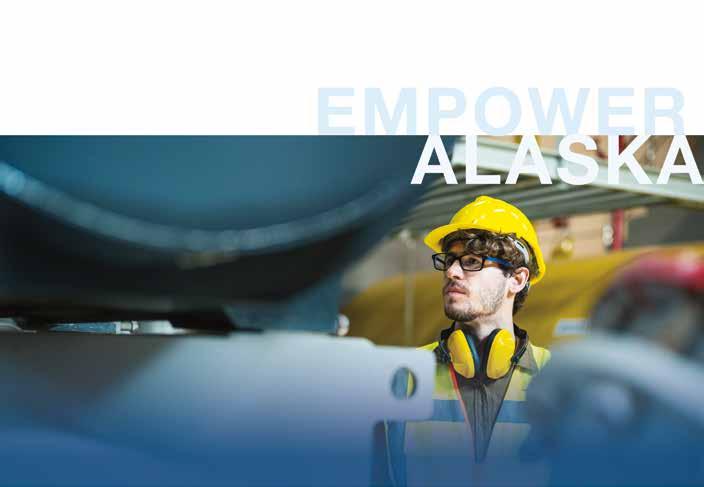
A teaching tool in use since 1982, ARE’s “box of rocks” includes forty specimens of rocks and minerals from across Alaska.
The

Creative Curricula
ARE offers an array of lessons that classroom teachers can pick from. “We teach about rocks and minerals, energy, forestry, and more depending on what the teacher wants,” says Toussaint. “For example, a teacher may request we come to the classroom to do a sixweek energy unit. In that series we will discuss what electricity is and what are the sources that make it.” Sometimes, the lessons are based on regions, such as in Northwest Alaska where mining is the main industry.
For forestry classes, students simulate consumption, recycling, renewal, and conservation of wood products using simple items like lima beans. Students also learn about the life cycle of a tree,
For rocks and minerals, students learn how to identify diverse types using scientific tools. They are also taught how rocks and minerals affect daily life. To learn about the mining industry, students go "mining" in a container of birdseed with hidden beads, which represent minerals of different values. The process teaches students how to make decisions about equipment, extraction, and reclamation techniques.
“Students absolutely love our programming,” says Toussaint. “It’s hands-on. It’s interactive and engaging with some level of competition. We even have them drill for oil in cupcakes!”
Oil and gas lessons go beyond taste tests, though, by including instruction in the processes of leasing, exploring, and planning.
Fun and games are fine for younger grades; for teenagers, the ARE curriculum gets serious.
“In the past couple of years, we’ve shifted our focus to workforce development, encouraging students to stay and work in Alaska,” Toussaint says.
ARE embarked on a mission to empower Alaskan girls to become the next generation of women leaders. Through its Powerful Opportunities for Women in Resources (POWR) program, ARE enlightens high school girls from across the state about potential careers in the natural resource industry.
Alaska Resource Education
which is one of the best ways to learn about trees. As a tree goes from birth to death, its physical form changes, as well as its role in the forest ecosystem.
ARE’s teaching methods about forestry include active participation where teachers ask young students to imitate their movements as they enact the life of a tree. For example, curl up in a tight ball to become a seed. Next, uncurl and kneel to mimic the sprouting of the tree. Then stick one arm up with a curled fist to indicate the growth of a limb. Wiggling toes indicates the growth of lots of little roots or rootlets. When the teacher makes a knocking noise, students learn about woodpeckers pecking into the tree’s dead wood.
“Many of the jobs in the natural resource industry have the stigma that they’re for the boys,” shares Toussaint. “We bring in women from across all of the industries to talk to the girls about crossing the boundaries and dispelling that myth.”
Through POWR, ARE encourages the girls to become innovative problem solvers and help tackle the big problems, all while staying in Alaska.
ARE leads this exploration each spring at King Tech High School in Anchorage through the “third session” afterschool program, which runs Monday through Thursday from 3pm to 5 pm. Upon completion, students earn a 0.5 elective science credit.
“Each day we will introduce a new topic and then bring in a woman working in that career,” explains Toussaint. “For the mining industry, we
could bring in a geologist, a blaster, heavy equipment operator, or a woman in environmental services.”
The program has been a momentous success for the high school girls who have attended. “We have girls who are struggling or even failing other classes who are getting A and B grades in this class,” shares Toussaint. “POWR is applicable, supported, and different from anything they’ve experienced.”
There is an optional five-day field trip in the summer, touring resource sites across the state. “We take a subset of the girls who want to go and allow them to see everything they learned about,” explains Toussaint.
In prior years, the POWR girls have visited a coal mine, a gold mine, a solar farm, a hydro research facility, a satellite lab, a large animal research facility, and more. The group travels by bus and stays in hotels and at partner facilities during the trip. ARE covers all expenses.
Field trips have proven to be a game changer for many of the girls. “One of our students became interested in carpentry and decided to study carpentry in college,” shares Toussaint. “She’s buying carpentry tools with her college scholarship and moving from cheerleader to carpenter.”


In addition to the Anchorage program this spring, ARE will offer a POWR camp at the UAS Technical Education Center in Juneau later this year.
Another program expansion is aimed northwest. “Last year we piloted a program called ‘ARE Rockstars’ focused on mining,” says Toussaint.
“This year we’re developing a version of that in the Bering Straits region and will be bringing students to NACTEC [Northwestern Alaska Career and Technical Center] in Nome to do an entire class on the entry-level careers in the mining industry.”
With funding from donors in Alaska’s resource industries, ARE occasionally receives questions about the transparency of its programs. Is the nonprofit essentially lobbying children? Does the organization have a hidden agenda?
“We do get those questions sometimes,” shares Toussaint. “We get financial support from the mining industry and the oil and gas industry



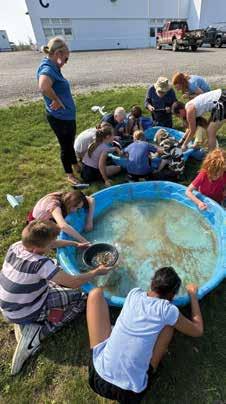
and, as a result, people do have some concerns that it is propaganda. But the reality is, we create a sciencebased and fact-based curriculum to teach about Alaska’s resource industries. We do not teach pro- or anti-anything, and we welcome people to join us in the classroom where they can see the workshops.”
ARE’s assistant program director Taylor Burgh received the Rising Star award last year from the Alaska Oil & Gas Association. Burgh is credited with having a transformational impact on oil and gas education, quickly rising through the ARE ranks, and spearheading initiatives such as POWR. She also teaches that resource development coexists with environmental protection.
But it’s not just businesses and industry associations that embrace ARE’s programs. Educators welcome the organization’s efforts, too.
According to its records, ARE reached more than 30,000 students from 2018 to 2022, in more than fifty communities. Smaller classes in the Powerful Opportunities for Women in Resources program have a chance to visit industrial sites during the summer.

Members of ARE’s board of directors include representatives from Alaska Native corporations and oil, mining, and transport companies. Continuing volunteer and financial support are signs that Alaska’s resource industries appreciate what ARE is doing.
The organization also garnered other acknowledgements. For instance,
“The passion and caliber of the instruction provided by the staff at ARE—all of which have vast industry, teaching, and Alaska experience—help them connect with our students in a way that is not easily replicated,” says Woodhead. “They are patient, operate through a cultural lens, and help advocate on behalf of our program with other potential partnerships, which can lead to several post-secondary training programs and careers. Our program would not be as strong without our relationship with ARE.”
Service High culinary arts teacher Melinda Moore agrees. “Alaska Resource Education provides students with the opportunity to touch, see, and apply natural resources to reallife applications,” she says in her testimonial. “My favorite is when students design and construct solar-powered boats and race them in a kiddie pool. It’s amazing, engaging, and educational!”
Furthermore, ARE’s reach goes beyond children to include continuing education at the college level. One program introduces adults to sustainable resource systems and renewable energy, as a framework for teaching the topic. Another course, Rock & Roll Around Alaska, facilitates field trips to industrial sites so teachers gain concrete experience with the abstract topics in the lesson plans.
The courses are certified by the UA System to qualify for a continuing education credit. In effect, ARE is teaching adults how to do what the organization itself does: inspire through scientific and careercentered activities.


By Tracy Barbour
Fr om creating content to automating processes, Generative Artificial Intelligence (GenAI) promises innovation, efficiency, and convenience for a wide variety of industries. It also presents unique risks, ethical concerns, and legal implications that cannot be ignored.
GenAI is a class of machine learning that can spit out text, images, videos, music, or software code based on patterns learned from vas t training datasets.
GenAI has been in development for many years, but it was catapulted into
the mainstream in 2022 when OpenAI released its human-like chatbot, ChatGPT. The app allows users to type a prompt to generate content almost instantly and effortlessly. Rapid advancements are pushing the possibilities of GenAI further. For instance, Microsoft is embedding its AI-powered CoPilot assistant in Windows, Edge, Office apps, and Bing. Adobe released an AI tool that can search and summarize PDFs.
The reception of AI-generated content is moving from curiosity to caution to, increasingly, acceptance. “Companies had to adapt quickly
because their employees were using it, and they’ve begun to see the potential for efficiency, innovation, and creating a competitive edge,” says Greg Starling, head of emerging technology at Anchorage-based Arctic IT. “Also, the conversation switch from ‘AI is taking my job’ to ‘AI is augmenting my creativity and productivity’ has been critical to g et people on board.”
What sets GenAI apart from previous technological leaps— from the mechanized looms of the Industrial Revolution to the
“AI is coming, no matter what someone thinks about it… That doesn't mean the fears and hesitancies vanish. It means we have to address them openly, with a focus on
harnessing
AI's potential responsibly and ethically.”
Greg
Starling Head of Emerging Technology, Arctic IT

In In the ever-evolving realm of magazine publishing, C.S. Lewis’s poignant words, “Isn’t it funny how day by day nothing changes, but when you look back, everything is different?” resonate deeply. Reflecting on my journey with Alaska Business since 1998, the magnitude of transformation within our publication’s landscape is awe-inspiring. In 1998, Alaska Business was already a seasoned industry player, entrenched in traditional printing methods. Filmto-plate technology reigned supreme, while our communication tools were rudimentary—a solitary email address for the entire company and dial-up internet
access sufficed. Fast-forward to today, and the evolution is nothing short of staggering.
Now, Alaska Business stands proudly at the forefront of the digital revolution, embracing state-of-the-art technologies to revolutionize our operations. With computer-to-plate technology, an innovative digital magazine, weekly newsletters, and an acclaimed website, we’ve shattered boundaries, engaging audiences in unprecedented ways.
As we prepare to mark our 40th anniversary in 2025, Alaska Business embodies resilience and adaptability. Weathering economic storms, industry disruptions, and shifting reader preferences, we’ve not merely endured but flourished. Charles Darwin’s wisdom rings true—survival hinges not solely on strength or intellect but on our capacity to embrace change.
Peering into the future, the trajectory of the magazine industry remains tantalizingly unpredictable. Technological advancements will redefine the very essence of magazines, altering content
delivery and reader engagement. Amid this flux, our commitment to evolution remains unwavering.
Alaska Business isn’t merely adapting; we’re pioneering. Skillfully navigating the digital terrain, we leverage our website, digital edition, social media platforms, newsletters, and multimedia channels to forge deeper connections with our audience.
As we embark on this expedition into uncharted territory, one truth shines brightly—Alaska Business transcends being just a magazine; it’s a testament to innovation, resilience, and the enduring spirit of transformation. With each passing day, we embrace change driven by our steadfast dedication to serving you. After all, Alaska is not just our business; it’s our mission and passion.

Charles Bell Vice President of Sales & Marketing 907-230-8213
cbell@akbizmag.com
e-commerce that wiped out bookstore chains—is its encroachment into professional-c lass creative work.
“AI is coming, no matter what someone thinks about it,” Starling says. “That doesn't mean the fears and hesitancies vanish. It means we have to address them openly, with a focus on harnessing AI's potential respons ibly and ethically.”
According to Jeff Vogt, Alaska Communications COO, the AI revolution is accelerating more rapidly than anyone anticipated. “We see increasing levels of acceptance, experimentation, and adoption as AI moves from a novelty to a major disruptive technology with real-world applications that will improve all our lives,” he says.
To keep pace, Vogt believes everyone will need to incorporate AI into their personal and professional lives. Alaska Communications is setting an example by incorporating GenAI in its operations. “For instance, incorporating AI chatbots for customer support is increasingly commonplace and is becoming more accepted by consumers,” says Vogt. “In areas where we can improve the customer experience (e.g., during off hours when staff is unavailable), we believe AI can deliver real value to both the busines s and the consumer.”
A primary risk of GenAI is its potential to supply incorrect information, according to Kenrick Mock, professor of computer science and engineering and dean of the UAA College of Engineering.

“Small errors in an AI-generated thank-you message may be no big deal, but errors in an AI-generated response to a specific query from a customer could be more si gnificant,” he says.
Another major risk, Mock says, is how customers perceive a business using AI-generated content. “It could be looked upon less favorably if the expectation is that a human expert is sup erior,” he explains.
Mock encourages companies to be open and transparent when AIgenerated content is used. “Sports Illustrated and CNET are examples where stories were published with the unknown assistance of AI, and the backlash was severe when discovered,” he says. “If customers expect that a human is generating the content but a machine is really behind the scenes, this amounts to deception. On the other hand, when it is clear that AI is generating content, this is generally accepted.”
Starling says concerns about GenAI should always start with accuracy, as AI can sometimes blend fact with fiction.

“Hallucinations,” as these spurious results are called, can create real problems. “Recently, a Canadian court ordered Air Canada to refund a customer what their AI chatbot had told the customer they would get refunded. The problem was that the policy the AI quoted didn't exist,” Starling explains. “AI can make up medical treatments that are not the best path forward, or as it did recently, recommend a food bank as a hot place to eat for visitors c oming to your city.”
Another ethical issue is the potential for bias. Starling says, “These systems mirror the biases present in their training data and then again will have biases incorporated by teams trying to remove those initial biases. Every system has its own biases, which significantly affect the outputs you see in the results.”
As a prime example, Google’s Gemini chatbot (formerly called Bard) recently drew strong criticism when it generated images of certain historical people using the wrong ethnicity or gender. Trained to avoid bias against minorities, it overcorrected and rendered images of a female pope, for instance, and the Founding Fathers and Nazi soldiers as people of color.
Privacy can also be a problem. “Unless you're on a platform that
states it won't use your information for training, it will use your information for training—even if your input is very personal or private,” Starling says. “It can get even worse in the corporate world when you run an AI against your entire infrastructure. It's like inviting a stranger to rummage through your attic; you're never quite sure what they'll find or how others in your company might use what they find now that what was hidden is readily available.”
Beyond inaccuracy, bias, privacy, and other ethical issues, possible legal problems may arise. Currently, there are few laws relating to AIgenerated content, but a variety of legislatio n has been proposed.
In Alaska, for example, a bill was introduced in February relating to AIaltered representations of people, known as deepfakes. Furthermore, according to Wendy Kearns, a partner at the law firm of Davis Wright Tremaine, “Alaska became the first state to adopt a requirement governing insurers’ use of AI, which includes, among other things, that insurers’ decisions resulting from the use of AI must not be inaccurate or unfai rly discriminatory.”
Davis Wright Tremaine operates about a dozen offices nationwide, including one in Anchorage. Kearns is based in Seattle and chairs the firm’s Techno logy practice group.
She says the legal community is eagerly watching various AI-related lawsuits across the US. “Many of these claims relate to the training data used to provide the AI systems,” Kearns says. “For example, there are suits claiming that AI systems infringe on the copyright of the original data because the output is creating derivative works of the original copyrighted material. There is at least one suit claiming defamation relating to output of AI material. We expect to see a whole variety of actions continue in the years to come and case law to be more robustly developed in this area, which will help resolve some of the legal uncertainty.”
While it does appear that content generated solely by AI is not copyrightable, Kearns says, there is an
“Living in a society where people can’t determine what information to trust should be a concern for all of us. We all have to learn to spot and counter mis- and disinformation and grow our media literacy.”
Michelle Egan Director of Corporate Communications, Alyeska Serv ice Pipeline Company
open legal question about how much human authorship is needed to cross the threshold int o being protectable.
Government entities, AI companies, trade associations, and others are increasingly implementing measures to mitigate the risk of using GenAI. In February, for example, the National Institute of Standards and Technology created the US AI Safety Institute Consortium. AI creators and users, academics, government and industry researchers, and civil society organizations united to develop and deploy safe and trustworthy AI. These stakeholders will ultimately develop science-based and empirically backed guidelines and standards for AI mea surement and policy.
Some AI companies have vowed to protect customers against lawsuits related to using their products. OpenAI offers Copyright Shield; Microsoft has CoPilot Copyright Commitment; and Adobe says it will defend customers against intellectual property lawsuits stemming from the use of its AI image generator, Firefly. Tech companies are also taking more responsibility for guiding the ethical use of GenAI. In February, Microsoft launched a program to help partnering news outlets and journalism schools adopt AI tools and techniques while upholding ethical standards.
And to make AI-created images more identifiable, Meta will be adding "AI-generated" labels to artificially generated third-party images posted on Facebook, Instagram, and Threads. OpenAI will also start watermarking images gene rated using ChatGPT.









Companies that learn to leverage AI technology in a safe and ethical manner will have an advantage over those that resist— and over those that charge ahead without safeguards.
The first step, according to Michelle Egan, director of corporate communications for Alyeska Service Pipeline Company, is to understand potential uses of GenAI. “Once you have that understanding, review the tools through the lens of your company or professional values and code of conduct,” she says. “The next step is to create a policy for using AI and plan to update it frequently. Do you have a strategy for adopting and deploying new tools? How will you assess them for appropriateness and effectiveness?”
UAA College of Engineering Dean Kenrick Mock agrees. “Continuous testing of performance and monitoring of feedback is necessary to detect issues and make adjustments,” he says. “This might be implemented with the assistance of a review board with diverse perspectives.”
In business, Alaska Communications COO Jeff Vogt says, it will become necessary for companies to train AI on proprietary information. “This will allow for the personalization of customer experiences, improvements to the repeat decisions that are made throughout the business, efficiency gains that augment the employee experience, and ultimately lead to competitive differentiation,” he says.
Arctic IT Head of Emerging Technology Greg Starling also advocates experimenting with GenAI. “Try different services and technologies—but get in the game,” he urges. “Businesses can lead by example, demonstrating that it is possible to harness the benefits of AI in ways that reflect our highest aspirations for society. I dream the legacy of AI is one of empowerment and creativity, not the opening scene of a dystopian sci-fi movie. The only way we get there is to all jump on board together and create the future we want.”
These efforts are commendable, Starling says, but barely scratch the surface of the ethical iceberg. “The initiatives represent steps in the right direction but are really putting a band-aid on a bullet wound,” he says. “Watermarks, for instance, aim to distinguish AI-generated content from human-created content, adding a layer of transparency. This is an afterthought and is easily beatable by running the image through another AI tool and simply asking it to, ‘remove the watermark.’”
Recently, the Public Relations Society of America (PRSA) took a crucial step in educating its 25,000 professional and student members on AI opportunities and challenges. The industry group considers misinformation and disinformation to be a primary ethical challenge. “According to the Institute for Public Relations, the majority of Americans consider mis/disinformation more of a threat to society than concerns like terrorism, border security, and climate change,” says Michelle Egan, who served as the PRSA national chair for 2023. “Tools like generative AI make it even easier for mis- and disinformation to proliferate.”
Egan, the director of corporate communications at Alyeska Service Pipeline Company, adds, “Living in a society where people can’t determine what information to trust should be a concern for all of us. We all have to learn to spot and counter mis- and disinformation and grow our media literacy.”
Attribution and disclosure are also concerning issues for PRSA. “Users have the same responsibility to cite sources in their work product as we do without AI tools,” Egan says. “What is the threshold for disclosing that AI was used in a work product? Can you use it for brainstorming and research without disclosure? How much of your document will you have AI draft before you disclose its use?”
Egan feels that communications professionals are responsible for building trust between organizations, the public, and society at large. That’s why, when she began her term as PRSA chair in 2023, she identified AI and mis/disinformation as two issues
of “great concern.”
To protect consumer privacy and remove or eliminate bias, companies must introduce data governance frameworks for how to use GenAI.
That’s precisely what Alaska Communications is striving for, says Vogt. The telecom formed an AI Leadership Council—with top executives from legal, IT, security, customer experience, and network operations departments—that meets regularly to address the implications.


“We’re excited at what AI can do to improve both the customer and employee experience,” Vogt says. “At the same time, we work with a lot of customer data. Every use case for AI will have a policy on how to use it while protecting customer data that balances our desire to be innovative with a foundational principle of operating both responsibly and ethically.”
The proactive stance of Alaska Communications and PRSA exemplify Kearns’ general recommendations for organizations. She says, “We encourage our clients to have a written internal policy to guide employees on when and how to use Generative AI. These policies should be developed in a cross-functional manner with buy-in from stakeholders— technology, legal, risk management, business functions, privacy, and HR [human resources]. There’s no right answer for any particular company; only that it be thought-out, preferably in advance, and that there is cross-company buy-in.”

And while some people fear AI will replace human effort, Kearns feels the technology will help people do their job more efficiently and better than they would without it.














Redundant internet, custom voice solutions and more. Stay connected and competitive with our tailored business services. MTA’s dedicated business representatives will help you identify and deliver the technology needs that will help your business grow.






By Vanessa Orr


Wh ile talented musicians are found all over the world, those living in Alaska believe there’s something special about the sounds from their home state.
“Music and performances are inevitably unique because we live in a unique place,” says Kat Moore, a pianist and singer in Anchorage. “It’s inspiring and beautiful and intense in ways that react with our emotions, maybe more so than for those who live in more temperate climates. I feel like there is an intensity to living in Alaska in general, and for me as an emotional writer, that becomes manifested in my writing.”
The midnight sun provides an opportunity to interact with other performers in summer, and the colder months provide time for introspection. “The isolation factor in winter makes music more impactful when people do get together,” Moore says.
Not only does Alaska breed some extremely talented musicians, but the local culture engenders respect for those who perform.
“Fact is, we’re up here on an island, so to speak, so we have to provide our own 365 degrees of entertainment,” says Kurt Riemann, owner of Surreal Studios, which has produced more than 1,000 albums for Alaska musicians since 1982. “We don’t have people drifting into town from the next state over and performing; our isolation provides a more communityoriented type of music.”
Riemann believes the strength of Alaska’s music scene is shown by the number of people who attend performances. But how many attendees or performances are there?
The Alaska Music Census sheds light on how important performers are to the state’s culture and economy. The census is led by the Alaska Independent Musicians Initiative (AKIMI), a nonprofit formed in 2016 to elevate Alaska music and support Alaska musicians.
Last summer, AKIMI surveyed 1,330 music makers. Of that group, 2 percent make a living as music teachers but not artists, 68 percent are musical artists but not teachers, and 30 percent are both.
“We found that many musicians play three or more different roles for which they get paid—for example, as performers, educators, and recording artists releasing music, or as agents booking music for someone else,” says Marian Call, a singer and songwriter based in Juneau with nearly a dozen albums to her credit. Call is also AKIMI’s program director.
The census found roughly 62 percent of musicians surveyed earned money over the last four years from music, and 25 percent said more than half of their income comes from music. Another finding is that music activity supports 1 percent of Anchorage’s total workforce.
“What AKIMI has done with this survey is let musicians know that they are genuinely providing a service; that they have a marketable skill,” says Moore. “Secondly, they are showing that our work is valuable to the economy.”
Moore stays busy performing as a solo artist under the name The Forest that Never Sleeps. She is also part of the five-piece Super Saturated Sugar Strings.
“It is the hardest thing to put a quantifiable fiscal value on art; for us as artists, it feels soulless to say, ‘I’m worth this much,’” Moore says. “An arts organization that has funding may offer us $1,500 for one performance; another less-funded venue may offer $500. So ‘worth’ becomes a constantly fluid and sliding scale.”
Yet quantifying economic impact was part of the goal of the Alaska Music Census, so dollar figures must be counted.
“It’s strange, because you create art because you want to and need to—it’s a beautiful esoteric thing,” Moore says. “But you do have to earn money in order to survive; you have to be able to make it financially.”
According to Call, the AKIMI survey tried to reach as many people as possible in Alaska’s music ecosystem.
“I know that ‘ecosystem’ sounds like a buzzword, but it’s also the best way to describe this tangled and very organic system,” she says. “People make music for money or for free, they teach music, and a lot of times these are all the same people in different spaces.”
“We want to encourage playing Alaska music in the background at hotels or using it in heliskiing operations— anywhere in spaces where tourists congregate. We also want to center Alaska music festivals in travel calendars.”
Marian Call Program Director Alaska Independent
Call adds that the ecosystem includes small businesses, such as venue owners, and the support industry of music retailers, recording studios, and instructors.
“It’s very hard to know exactly how many musicians are in Alaska because so many people do it without pay, yet it still adds value—both economic and cultural—to the community,” Call says.
AKIMI is using census data to generate various reports, starting with a special focus on Anchorage and Juneau released in January.
“With the information we have now, we can generate more

reports as people have time and access,” says Call, noting that the Anchorage/Juneau report was funded by those municipalities.
“We’d like to do a lot more in different communities, depending on funding, time, and the ability of communities to engage with us.”
In addition to the survey, AKIMI monitors the music scene, discovering which artists are playing in the state and sharing that information. It collates artists’ work so that it can be used in retail, tourism, and filmmaking, and the organization is working on a statewide directory of musicians and venues.
AKIMI also takes part in music export, identifying Alaska performers of national caliber who can be boosted
to higher visibility in state or Outside.
“We also collate music and playlists to get it out into public spaces and offer professionalization, workshops, connections, and mentoring for musicians,” Call says.
While many musicians choose to stay in Alaska and take advantage of the local scene, others go Outside to attempt a regional or national career. While Jewel (born and raised in Homer) and Portugal. The Man (formed in Wasilla) come to mind as successful artists, many others play throughout the Pacific Northwest or nationwide.
“Alaska musicians are players on the national scene, and while being from
“If you’re successful as a band elsewhere, it’s usually because a label is supporting you, which helps with touring, distribution, and getting stuff to radio stations… That core of support can help get the word out, which doesn’t really happen up here.”
Kurt Riemann Owner Surreal Studios
Alaska doesn’t bar us from that, it does take a lot of work,” says Moore. “It costs so much to get out, especially when traveling on an airplane with large instruments. Then you have to rent a vehicle and find places to stay.” She adds that she has seen a resurgence of young artists on tour outside the state, most especially on the West Coast and in Colorado, Utah, and Arizona.
“It’s a tough thing to be up against the Pacific Northwest and the bright, shining light that is Washington state,” says Riemann of the nearest competition, “so you have to have realistic ambitions. While Jewel, Portugal. The Man, and Nick Carpenter of Medium Build emerged out of here, it’s not easy to get label support.”
Talent alone cannot launch an artist into a successful career without the resources of a skilled marketing department.
“If you’re successful as a band elsewhere, it’s usually because a label is supporting you, which helps with touring, distribution, and getting stuff to radio stations,” says Riemann. “That core of support can help get the word out, which doesn’t really happen up here.”
Several individuals and organizations provide that support in Alaska, helping musicians find grants, venues, connections, and more. Riemann, for example, curates the Alaska Music Archives, a collaboration with UAA that’s been collecting music recorded in Alaska over the past eighty years.
“People send us their music, and there’s some amazing stuff out there,” he says. “A woman sent me a number of very short songs she wrote before and after a home birth, and they are gorgeous.”
Riemann has a soft spot for underdogs without wide exposure.
“Success nationally doesn’t necessarily mean that you did something great; it means that you’re working on the commercial aspect of the craft,” he says. “But what I’m after with the music archives is interconnection; that’s the way a community works. The archive’s music will soon be available from the library and there is a Band Wiki on our website so that people know what’s been going on up here, and so ‘homemade’ musicians won’t get discouraged.”
Moore used to organize her tours by searching venue websites, gradually building a name with outside markets. Moore and her band then connected with the Anchorage Concert Association and Arts Northwest to get the ball rolling for higher-tier gigs. Along the same lines, AKIMI is creating informational conferences and meetings so artists can understand their options to travel Outside.
“They provide ways to do it that are more intelligent and calculated than winging it or cold-calling the state of Idaho to find venues,” Moore says with a laugh.
She adds that Parlor in the Round, a singer songwriter show in Anchorage founded by Kevin Worrell, is another


"It’s very hard to know exactly how many musicians are in Alaska because so many people do it without pay," says Juneau singer Marian Call, "yet it still adds value—both economic and cultural—to the community."
North Photography and Alaska Music Zine
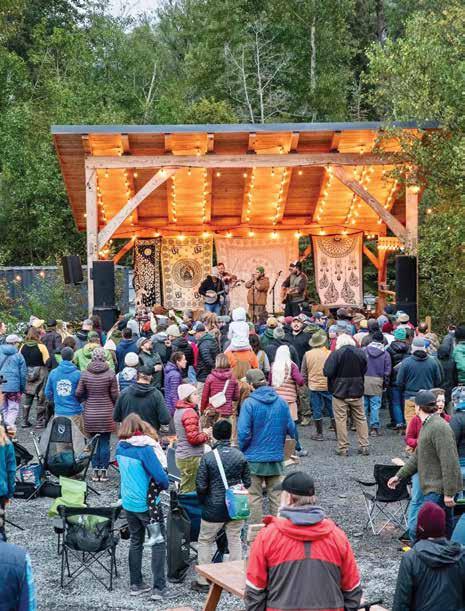
channel for Alaska artists to meet artists from the Lower 48. “On each show, they have two artists from Alaska and one from the Lower 48, and a national artist may even cover your song,” says Moore. “It’s a great way to interface intimately with artists doing what we’d love to do: to spread music beyond Alaska.”
AKIMI is helping to expand artists’ reach with its Alaska Playlist Project, which includes two dozen curated Spotify playlists featuring local performers. “The content is so good, and you can search for genre, region, Black Alaska artists, Indigenous performers, and more,” says Call. “Most people don’t even know how much Alaska music is out there, and now they can just hit play and hear musicians who are all from here, making incredible stuff.”
AKIMI also formally partnered with Washington, Oregon, and Idaho to form the Cascadia Music Corridor.
Working with the Alaska State Council on the Arts, the initiative helps musicians apply for grants from the Rasmuson Foundation and other donors and local arts agencies like the Valley Arts Alliance, Fairbanks Arts Association, and Juneau Arts and Humanities Council.
“This year, we are also participating in the Alaska Travel Industry Association conference to bring music information to tourism outlets,” says Call. “We want to encourage playing Alaska music in the background at hotels or using it in heliskiing operations—anywhere in spaces where tourists congregate. We also want to center Alaska music festivals i n travel calendars.”
Call compares musicians with graphic artists, who receive exposure every day from murals, stickers, or logos on apparel. She asks, “Everyone has t-shirts that show our Alaska pride—what if we expanded that to music as a matter of course, showing that we’re proud of our Alaska musicians and want to share our mu sic with the world?”
While many people are working to individually advance Alaska’s music, AKIMI hopes that the census will encourage musicians to, so to speak, band together and advocate for their work and its economic impact.
“We want to use these numbers to advocate for arts as a sector because we are mostly invisible. Aside from dining, things that happen after 5 p.m. tend to get forgotten from economic reports in general,” says Call. “We want to remind municipalities and the state that we exist and remind them that we are a business sector—one that is bigger than some of the smaller sectors that often get more attention from lawmak ers and economists.”
The sector includes, after all, not just professional musicians but performers with day jobs, all of whom stimulate business at restaurants, bars, c lubs, and festivals.
“Because most musicians are individually employed, it takes a lot of work to get together and advocate for ourselves in that space,” Call adds. “But music offices in other states have successfully used this type of information to increase investment in music infrastructure, in building better festival grounds, in getting more support for festivals, and in creating music-friendly policies like good sound ordinances and fully fun ded arts education.”
Call hopes that the census also identifies opportunities for investment. “In Portland, Oregon, for example, they put together Portland Music Month which generated hundreds of thousands of dollars and increased tourism ac tivities,” she says.
“There is tremendous music being made here, and it is creating a tremendous amount of value,” Call adds. “We just have to actively tend our music ecosystem.”








By Brian Walch
Ma nagers want more time to do meaningful work. They want better work-life balance and more energy for professional development. They have ideas for improving things and want to implement them. They have desires to grow at work and dreams for their career.
What stops them?
“Not enough time,” they’ll say. Their boss will respond, “You should delegate more.”
If only it were that easy. As if delegation is a magic wand that could make it all happen with a flick of the wrist.
It isn’t. Delegation takes work. A great manager must invest time to develop their skills and realize their desires. Alisa Cohn, a top-level CEO coach, says, “The number one job of a leader is to become a master delegator.”
Managers can develop their delegation skills by adopting a structured approach like the one below, putting it into practice, and adapting it to their situation. If they persevere, they and their teams will realize the benefits.
It is easy to assume the proper technique, framework, or method is all that is needed to become a master delegator. Although helpful, it isn’t the biggest hurdle to overcome.
The person delegating the work is the biggest obstacle. Here are some reasons people give for not delegating and what they are really saying:
“It will be faster if I do it myself.” In other words, “I’m too busy.”
“They aren’t ready to take that on yet.” They might as well say, “They can’t do it as well as I do it.”
“This is a core part of my job.” The unvoiced concern is, “What will I do if I don’t do that?”
“I need to be available for any issues.” They might be thinking, “They can’t survive without me.”
Although they sound like excuses, these concerns must be addressed to progress. To overcome these obstacles, discuss them and create counteracting statements like these:
“Yes, it is faster if you do it yourself. But investing time now will give you more time later.”
“No, they can’t do it as well as you, but they can do it well enough, allowing you to do more important things better.”
“Yes, it is core to your job now, but you want to grow. You must make space somewhere if you’re going to do something new.”
“Yes, they will survive, but with a few mistakes. People learn best through experience. Trust your team and allow them to grow.”
Even after addressing objections, it isn’t time to jump into delegation methods. Instead, consider who should have work delegated to them.
When I work with clients, I ask them to list all the people they could potentially delegate to, including direct reports, people in other departments, and vendors or customers.
Using that list, they can consider each person independently. Who do they work well with? Who could take on more work? What types of tasks could they take? Who is ready to advance in their career?
There will be nuances, caveats, and exceptions with each person on the list. That’s the point. Delegation relies on a relationship, which must be considered before selecting the work to delegate to them.
Reviewing the people often generates lots of ideas of things to delegate. Becoming a master delegator, however, requires continuously evaluating and categorizing the work so it is ready to be delegated. These are the types of tasks that are candidates for delegation:
• Work that is not energizing and not important. For instance, processing
receipts must be done but doesn’t have a significant impact on the business.
• Urgent but not important work. Examples include scheduling a meeting or ordering office supplies.
• Recurring work. This type of work has ongoing returns when successfully delegated but requires a commitment to the process. It can be demoralizing if the work must be pulled back.
• Project tasks. These can be run as experiments to see how someone does with additional responsibility and to learn how to delegate to them better in the future.
• Operational areas. Delegating areas of responsibility can provide employees with greater autonomy and authority to improve things.
With a list of people and a backlog of tasks, a master delegator can be a matchmaker, pairing work with people and increasing productivity and engagement.
Although delegation can be achieved by providing commands and direction, many tasks require a deeper discussion about the work, and it is an opportunity to develop a relationship. Before engaging in that discussion, the delegator must be clear about the desired result so that they communicate it well. They should be able to answer these questions:
• What is a successful outcome?
• When does it need to be completed? What is an acceptable level of quality and completeness?
• What level of authority are you giving the person? For reference, see Michael Hyatt’s “Five Levels of Delegation.”
The preparation will improve the quality of the delegation discussion. An effective discussion should have the following attributes:
• Describe what results are expected.
• Spend more time describing the goal than the process.
• Explain the plan for check-ins and follow-up.
• Verify the necessary support is available.
• Create space for negotiation. The discussion should allow for open dialog about the schedule, quality, or other aspects that can be adjusted to create a successful outcome. After
the person has had time to process, a follow-up meeting can ensure they are still confident about the plan.
Delegating is like investing. It takes patience and perseverance. Not every investment pays off, but with a portfolio of reasonably intelligent investments over time, there will be a good return. Although people are energized when brainstorming about who and what they can delegate, it is hard to follow through. Delegation relies on people and relationships, which often have variable results. Employees leave, things change, or the delegated work is no longer needed. Master delegators take a portfolio approach and recognize that not every effort to delegate will be successful.
Like investing, any individual investment can go down before it starts to rise. In economics, this is referred to as the J-curve. The same thing happens when delegating. Productivity and results take a dip before they start going up. Making it through the delegation dip requires a commitment to the process and patience for results. Those who can make it through become better at delegating and realize its benefits.
There are pitfalls, no matter how much preparation, attention, and commitment are given to the process. These can hinder effective delegation, but bringing awareness will help mitigate their impacts.
• Under-supporting the effort: Sometimes, employees don’t know what they don’t know, leading to insufficient support from the delegator or organization. Mitigate this by discussing the work and the plan and then checking back after they’ve had time to process it.
• Micro-managing the work: Delegating work will grow the capacity and competency of a team. However, micro-managing the work will have the opposite effect and must be guarded against. Delegators should define the desired outcome, provide the support requested, and wait until the end to evaluate the results.
• Overthinking what to delegate: This can happen when organizing
what to delegate and not moving forward on how to delegate. To overcome this, start small and practice pairing people to work. This builds the skills and trust of the team. More significant strategic initiatives will become apparent as the team gains momentum.
• Delegating too much too quickly: When someone fails, it hurts their confidence, erodes trust, and causes delegation to stagnate. Master delegators start slowly and run experiments or conduct miniprojects to help people grow. This allows them to expand when it goes well and reevaluate when it doesn’t.
• Not considering others: Others will notice work and responsibilities being delegated and may interpret it as a potential promotion or other imminent change. Recognize that some delegation initiatives will require greater levels of communication with the larger team.
Managers are motivated to find ways to achieve their goals. As they become master delegators, they will have more time and energy to invest in themselves and their teams.
The delegation process requires developing relationships, working together, and trusting others. As managers delegate, employees will observe and learn, allowing them to grow and develop.
Creating an organizational culture of delegating well can lead to improved engagement, higher trust, and increased collaboration. The organization becomes more resilient, productive, and able to grow.
Delegation may not be a magic wand, but it can turn dreams into reality.
Brian Walch is an executive coach, consultant, and speaker on leadership development. He uses his extensive experience in people and systems to provide tools and services to empower managers to lead themselves, their teams, and their organizations.

The winner of the US Small Business Administration’s 2024 State Small Business Person of the Year for Alaska is the owner of The Waterworks, Kali C. Bennett. The company, with two locations in Anchorage and Eagle River, sells hot tubs, spa tubs, swimming spas, and sauna equipment. Bennett’s parents started the company in the ‘70s, and Bennett recently completed the Small Business Administration’s executive training program, T.H.R.I.V.E. Emerging Leaders Reimagined. As Alaska’s State Small Business Person of 2024, Bennett was invited to the National Small Business Week awards ceremony held in Washington, DC, late last month. alaskaspa.com
The thirteenth location for ARG Industrial extends its reach to a new state. The Anchorage-based supplier of hoses, rope, and rigging products opened a shop in Hayden, Idaho—less than an hour’s drive away from the company’s Spokane, Washington branch. “The area is experiencing rapid growth north of Coeur d’Alene along the Highway 95 corridor,” says president and CEO Mike Mortensen. “This branch is strategically positioned to meet the region’s increasing demands for the products and services we provide.” The employee-owned company has grown by acquisitions throughout Alaska, Washington, and Oregon. alaskarubbergroup.com
Shoppers in Delta Junction have a local market again, two years after the old grocery store’s roof collapsed. The rebuilt IGA Food Cache opened in March, a few months after the owners opened a new Subway franchise and gas station mini-market. Ed Larson, who owns the Independent Grocers Alliance store #158 in Delta Junction, called in his son Jeff, who manages a produce wholesaler in Seattle, to help coordinate the reconstruction
amid shortages of materials, equipment, and contractors. foodcache.iga.com
Designing production modules to be trucked to the Pikka project on the North Slope has big advantages for Santos. Instead of sealift by barge, transporting the 90-ton units by truck up the Dalton Highway spreads work over a longer season. It also saves about $200 million to $300 million, Santos SVP of External Affairs Joe Balash told state legislators in February. Around the same time, Santos CEO and Managing Director Kevin Gallagher said pipeline construction might wrap up in two winters instead of three, hinting that Pikka could produce first oil in 2025 instead of 2026. santos.com/north-america
A state-held North Slope unit is back in private hands. On February 29, the Alaska Division of Oil and Gas approved a change of control for Mustang Holding and the Mustang Operations Center from the Alaska Industrial Development and Export Authority to Finnex Operating. Mustang is a field in the Southern Miluveach Unit, and it was in production for one month in 2019 under Brooks Range Petroleum. Finnex submitted plans to restore production from a pad about 4.5 miles west of ConocoPhillips Alaska’s Kuparuk Unit. finnexllc.com
Member-owners of Chugach Electric Association could buy into a community solar project planned for the utility’s South Anchorage substation, along the railroad tracks just north of 100th Avenue. The Regulatory Commission of Alaska approved a three-year pilot project, which would install 1,280 solar panels generating about 500 kW. The project is meant for Chugach
customers unable to install solar panels on their own property. Construction is expected to be finished by summer 2025. chugachelectric.com
What capabilities do new computer tools based on machine learning offer to businesses? The Artificial Intelligence Resource Center (AIRC) would know. The Alaska Small Business Development Center at UAA launched the AIRC in March as a point of contact for entrepreneurs curious about new technologies.
Executive Director Jon Bittner describes AIRC as the first of its kind in the country. aksbdc.org/services/ai-resource-center
Since the new Petroleum and Cement Terminal opened last spring, the Don Young Port of Alaska has been busier than ever. Nearly 2.3 million tons of petroleum products flowed through the port in 2023, the most ever handled in a year. Nearly 155,000 tons of cement moved across the docks in Anchorage, a surge since the year before and the most since at least 2007. The vital building material arrived on five ships, up from the usual four. portofalaska.com
The sale of Anchorage-based fiber optic cable company Quintillion to a global investment firm is complete. Grain Management formally acquired QSH Parent Holdco, the holding company for Quintillion. The company has an ambitious plan to connect east Asia with Europe via the Arctic Ocean, starting with a subsea cable that links coastal villages from Nome to Utqiaġvik. Bank Street Group served as Quintillion’s financial advisor and Morgan, Lewis & Bockius was the legal advisor, while Cooper Investment Partners and Alston & Bird advised Grain.
quintillionglobal.com



· A portfolio company of Chugach Alaska Corporation has a new General Manager. Shane Jolin was appointed to lead All American Oilfield, overseeing operational performance for oil and gas drilling and professional services contracts across Alaska. Jolin, a veteran of the US Marine Corps, has more than two decades of petroleum experience, including work with Schlumberger and CH2MHill, and is certified as a project management professional.

· Bowhead Transport, part of Ukpeaġvik Iñupiat Corporation’s UIC Commercial Services division, hired Todd Santangelo as Director of Operations. Santangelo comes to Bowhead Transport after ten years at Arctic Slope Regional Corporation, most recently as procurement and supply chain manager. In his new role, Santangelo manages all operational aspects of Bowhead Transport. Santangelo earned a bachelor’s degree in business administration from UAA with a focus on supply chain management and logistics.

· Gretchen Meyers is back at R&M Consultants as a Senior Land Surveyor in the firm’s geomatics department. Meyers previously worked at R&M from 2010 to 2014,
when she left to raise her children. “Jumping back into a career after taking time off is not easy, but I knew R&M would have the guidance and mentorship I needed,” says Meyers. Meyers has a bachelor’s degree in geomatics from UAA and is a member of the Alaska Society of Professional Land Surveyors.

· Among multiple disciplines covered by Coffman Engineers, the firm adds a new capability for control systems at its Anchorage office by hiring Amber Benham. She received double bachelor’s degrees from Montana State University in chemical engineering and biological engineering. Benham has nine years of experience in the refining industry, designing process control automation, instrumentation, and alarms.

· Altman, Rogers & Co., Alaska’s largest locally owned certified public accounting firm, expanded its ownership group. Katie Stachow, the senior audit manager at the firm’s Anchorage office, was promoted to Principal and Shareholder, the firm’s eighth. Stachow has been with Altman, Rogers & Co. since 2009. Stachow earned a bachelor’s degree in accounting and public administration from Carroll College in Montana and is a certified public accountant. She also serves on the finance council for the Archdiocese of Anchorage-Juneau.

· Darren Franz, senior executive officer and chief credit officer at First National Bank Alaska, is now President of the bank’s Lending Division line of business. Franz remains Chief Credit Officer and is also elevated to the bank’s board of directors. Franz earned a bachelor’s degree in finance and economics and is a graduate of Pacific Coast Banking School.
Northrim Bank promoted three officers and added two new employees to its team.
· Samrie Canales is now Associate Vice President and Branch Manager at the Eastside Community Branch in Anchorage’s Muldoon neighborhood. Canales started at Northrim in 2021 and has more than ten years of customer service and management experience.
· Andrew Heckman joined Northrim in December as Associate Vice President and Branch Manager at the Fairbanks West Community Branch. He holds a bachelor’s degree in criminal justice from UAF. Born and raised in Fairbanks, Heckman recently moved back to Alaska.
· Elisa Borcherding is promoted to Assistant Branch Manager, Float Pool. Borcherding has been at Northrim for three years and has six years of banking industry experience. A life-long Alaskan, she is finishing a bachelor’s degree in financial management from Penn State University.
· Josh Fuentes joins Northrim as Assistant Branch Manager at the Lake


Otis Community Branch. Fuentes started with the bank in December after working for ten years in the financial industry in California and Texas. Fuentes holds a business analyst certification from Purdue University.
· Taylor Ladenburger is promoted to Commercial Loan Officer. Ladenburger joined Northrim in 2021 and has three years of financial industry experience. He holds a bachelor’s degree in business economics with a minor in business analytics from the University of South Dakota.
Two officers of Mt. McKinley Bank earned promotions.

· Carmen Randle is now Senior Vice President, Finance. Randle serves as the finance officer and audit manager for the bank. Randle joined the Mt. McKinley Bank team in 2019 with more than twenty years of experience in the accounting and finance industry in Fairbanks. She received a bachelor’s degree in accounting from UAF and is a certified public accountant.

· Jasmine Pletnikoff is promoted to Vice President, Controller. Pletnikoff joined the Mt. McKinley Bank team in 2020 with more than fifteen years of accounting experience. She worked her way up from teller and loan clerk throughout high school and college. She graduated from UAF in 2005 with a bachelor’s degree in accounting.
· Anchorage accounting firm Thomas, Head & Greisen appointed Carrie J.

Garrity as a Director. Garrity, a certified public accountant licensed to practice in Alaska and Oregon has been with the firm since 2014. She earned her bachelor’s degree from Black Hills State University in South Dakota and her MBA from Cameron University in Oklahoma.
The Anchorage law firm of Landye Bennett Blumstein (LBB) added three new partners and an associate attorney.

· Andy Erickson has been with LBB since 2016 and became a Partner in January 2024. His practice focuses on Alaska Native, municipal, natural resources, and appellate law. Erickson earned a bachelor’s degree from the University of Montana, a master’s degree in environmental policy at the University of Oxford, and a JD from Lewis & Clark Law School. Erickson worked as an Alaska Supreme Court clerk and a US Senate policy fellow.

· Doug Karet joined LBB as a Partner in November 2023. Karet regularly represents general contractors, subcontractors, owners, and design professionals, and he is a member of the Associated General Contractors of Alaska. Karet earned his bachelor’s degree from the University of Massachusetts Amherst and his master’s degree and JD from the University of Colorado. Licensed to practice in Alaska and Colorado, he specializes in contracts and litigation.
· John Crone also joined LBB as a Partner in November 2023. He works in employment, construction, commercial,

and administrative matters. Crone also advocates for clients before Alaska's Marijuana Control Board. Crone earned a bachelor’s degree from Columbia College Chicago and a JD from the University of Denver Sturm College of Law. He is licensed to practice in Alaska and Colorado.

· Suzanne Adler joined LBB as an Associate Attorney in January 2024. Her practice focuses on business litigation, employment law, and natural resources.
Adler earned a bachelor’s degree from Stonehill College in Massachusetts and obtained her JD from Boston University School of Law. She moved to Alaska in 2016 and clerked for Superior Court Judge Louis J. Menendez in Juneau and Superior Court Judge Bethany S. Harbinson in Fairbanks.

· First Alaskans Institute (FAI), a statewide nonprofit advancing Alaska Native voices, has a new President and CEO. After a nationwide search, FAI selected Apagzuk/Apagruk Roy Agloinga as the successor to La quen náay Liz Medicine Crow, who led FAI for the last twelve years. Apagzuk/Apagruk is the Yup’ik/ Iñupiaq spelling of his name, and he goes by both to honor both identities. He comes to FAI with a background in nonprofit management, philanthropy, rural health, government policy, and Iñupiat language preservation. Most recently, he served as an external affairs and granting program officer for the Rasmuson Foundation.














On e for the money, two for the show, three to get read y, now go census go!
The importance of music to Alaska’s economy and culture has long been assumed, but nobody tried to quantify it until last year. Vanessa Orr’s article “Alaska Music Census: The bottom line of show business” explains why the Alaska Independent Musicians Initiative sought to gather the data and how the nonprofit hopes to use the findings.
So far, numbers have been crunched for Anchorage and Juneau in a report published last October by global consulting firm Sound Diplomacy. This edition of Alaska Trends illustrates some of those findings. To understand the enumeration of “music assets,” the report defines the five “links” in the “music ecosystem value chain.” Those are: creation (music makers themselves), distribution (broadcast and sale of recorded music), exhibition (everyone involved in performance spaces), production (local recording and sound publishing), and transversal (business affairs an d support services).
The report notes that Juneau’s music scene has a bigger impact per capita than Anchorage’s, if only because the capital city has fewer capitas. However, Anchorage weathered the COVID-19 pandemic better, losing 29 percent of economic output while Juneau d ecreased 58 percent.
The report recommends creating an independent music office (like the erstwhile Alaska Film Office), establishing a cultural funding agency akin to the Alaska Housing Finance Corporation, offering financial incentives for recording and production, launching a Music Entrepreneurship Accelerator, and partnering with tourism to develop Ala ska’s musical brand.
Some of those aspirations might be more realistic than others, but then again, there’s always an aspect of dreamweaving when musicians sing for their supper.
Music Ecosystem as Percentage of Local Employment:
• Juneau supported 1.7%
• Anchorage supported 1%
Gross Value Added (output minus costs)
• Anchorage $139.6M
• Juneau $21.5M
What book is currently on your nightstand?
Wish I could say something impressive here, but I haven’t touched one in longer than a streaming binge lasts [he laughs].
What charity or cause are you passionate about?
ANSEP, the Alaska Native Science and Engineering Program.
What’s the first thing you do when you get home after a long day at work?
I turn into a couch potato, preferably with snacks in reach.
What vacation spot is on your bucket list?
The Maldives before the ocean swallows them.
If you could domesticate a wild animal, what animal would it be?
I wouldn’t. They belong in their natural habitat.
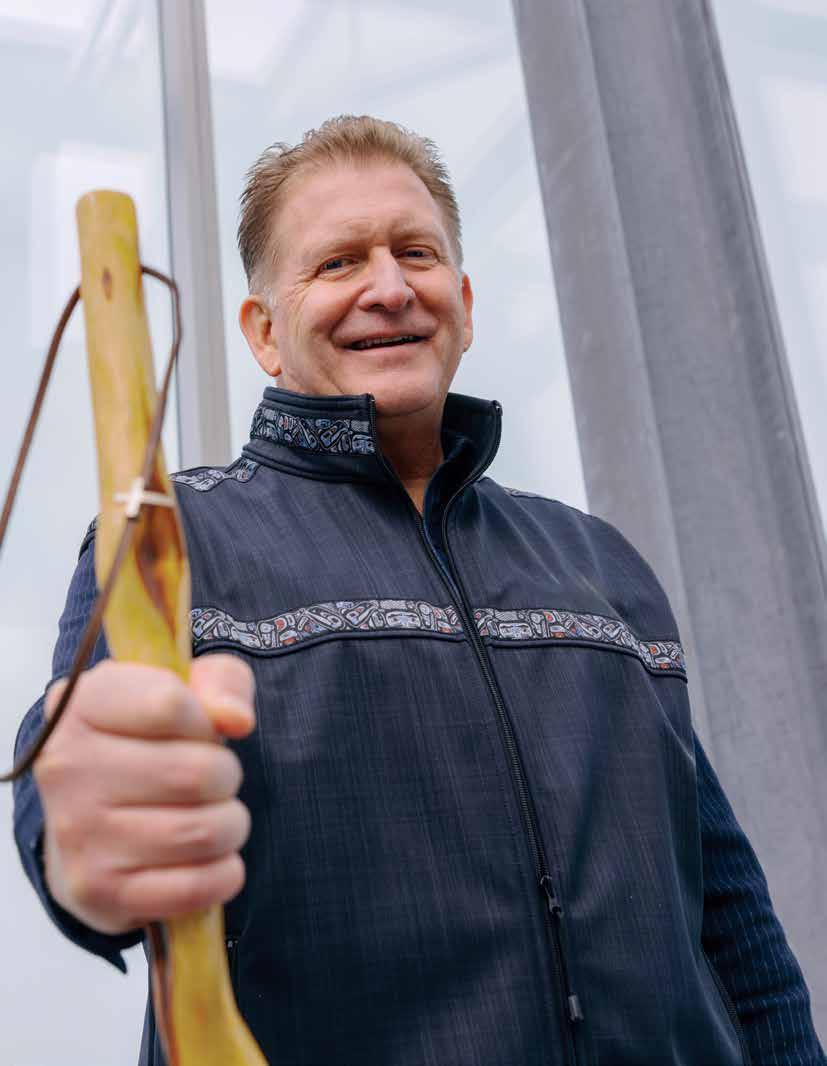
by Kerry
At a science fair in western South Dakota, young Bruce Dingeman presented his biomedical research. “I was doing work on laboratory rats,” he recalls, “doing hyperbaric oxygen treatment to increase healing rates.”
However, the Arab oil embargo steered his interest in science toward petroleum engineering, studying at the University of Wyoming. Dingeman (pronounced like “sing-a-man”) worked in Alaska during the ‘80s, and after the Cold War he taught capitalism in Russia.
In his career, he’s seen the expansion into deep offshore fields, the boom in shale oil, and the transition to alternative energy. As the Alaska president of Santos, Dingeman has overseen faster changes.
“Until late last year, I could walk the hall and know the name of every person in the organization,” he says, “but now I don’t have that level of familiarity because of all this growth.” Construction on the Pikka project swelled the staff from a handful in 2018 to, as of last year, about 200, plus 1,000 contractors. Thus, Santos is moving into larger quarters in downtown Anchorage.
“Not being stagnant, not standing still,” Dingeman says, “really drives a good day for me.”
Alaska Business: What do you do in your free time?
Bruce Dingeman: I buy all the gear but rarely use it, like any good imposter pretending to have free time… Doesn’t matter if it’s camping, fishing, hiking, skiing, whatever.
AB: Is there a skill you’re currently developing or have always wanted to learn?
Dingeman: I’m trying to learn to paint, and the feedback I’ve gotten varies from “That’s unique” to “How interesting.”
AB: What’s the most daring thing you’ve ever done?
Dingeman: A big pile of pig manure really can look like a gravel ramp to a kid on a motorbike, and I’ll leave it at that.
AB: What are you superstitious about?
Dingeman: Vegas has proven to me that superstitions don’t work.
AB: What’s your favorite local restaurant?
Dingeman: I like the chicken tikka masala at Everest, I like the pad thai at Thai Orchid, and the nachos at Southside Bistro.
AB: Dead or alive, who would you like to see perform live in concert?
Dingeman: Tom Petty.
AB: What’s your greatest extravagance?
Dingeman: I take every opportunity to buy nice [woodworking] tools, whether I need them or not.
AB: What’s your best attribute and worst attribute?
Dingeman: My worst is that I’m a champion overthinker. My best is that, in spite of that, I’m not afraid to make decisions.

Airport Equipment Rentals 115 airportequipmentrentals.com
Alaska Air Cargo - Alaska Airlines 39 alaskacargo.com
Alaska APEX Accelerator 19 ptacalaska.org
Alaska Dreams Inc 35 alaskadreamsinc.com
Alaska Oil & Gas Association 67 aoga.org
Alaska Pacific University 89 alaskapacific.edu
Alaska Safety Alliance 45 alaskasafetyalliance.org
Altman, Rogers & Co. 65 altrogco.com
Anchorage Convention Centers 37 anchorageconventioncenters.com
Anchorage Sand & Gravel 81 anchsand.com
Arcticom 29 arcticom
ASRC Construction 75 asrcconstruction.com
Calista Corporation 91 Briceequipment.com
ConocoPhillips Alaska 33 alaska.conocophillips.com
Conrad-Houston Insurance Agency 20 chialaska.com
Construction Machinery Industrial 2 cmiak.com
Cook Inlet Tug & Barge Inc 65 cookinlettug.com
Crowley Fuels 43 crowley.com
Cruz Companies 48 cruzconstruct.com
Denali Commercial 13 denalicommercial.com
Denali Universal Services ............... 79 denaliuniversal.com
Dorsey & Whitney LLP 63 dorsey.com
Doyon, Limited 75 doyondrilling.com
ENSTAR Natural Gas Co 73 enstarnaturalgas.com
Equipment Source, Inc 107 esialaska.com
First National Bank Alaska 5 fnbalaska.com
GCI 3 gci.com
Hotel Captain Cook 24 captaincook.com
JD Steel Co Inc 17 jdsteel.com
Landye Bennett Blumstein LLP 31 lbblawyers.com
LifeMed Alaska 69 lifemedalaska.com
Lynden 116 lynden.com
Material Flow & Conveyor Systems, Inc. 25 materialflow.com
MT Housing Inc. 47 mthousing.net
MTA - Matanuska Telecom Association 97 mtasolutions.com
Nenana Heating Services, Inc 23 nenanaheatingservicesinc.com
Nortech Environmental & Engineering........................................51 nortechengr.com
Northern Air Cargo 108, 109 nac.aero
Northrim Bank 15 northrim.com
Oxford Assaying & Refining Inc 103 oxfordmetals.com
Parker, Smith & Feek 85 psfinc.com
Personnel Plus Employment Agency 89 perplus.com
Petro Marine Services 59 petromarineservices.com
Republic Services 71 RepublicServices.com/ES
Resolve Marine 49 resolvemarine.com
Resource Development Council 41 akrdc.org
Santos 77 santos.com
Sheet Metal Inc 21 sheetmetalinc.com
Sourdough Express, Inc. 62 sourdoughexpress.com
State of Alaska Department of Health 95 medicaidrenewals.alaska.gov
T. Rowe Price 9 alaska529plan.com
Teamsters Local 959 50 akteamsters.com
The Plans Room 23 theplansroom.com
TOTE Maritime Alaska LLC 7 totemaritime.com
Tutka, LLC 27 tutkallc.com
Udelhoven Oilfield System Services, Inc 45 udelhoven.com
United Way of Anchorage 11 liveunitedanc.org
University of Alaska Office of Public Affairs 87 alaska.edu
Westinghouse Electric Company LLC 61 westinghousenuclear.com
Westmark Hotels - HAP Alaska 19 westmarkhotels.com
Yukon Equipment Inc 83 yukoneq.com


















